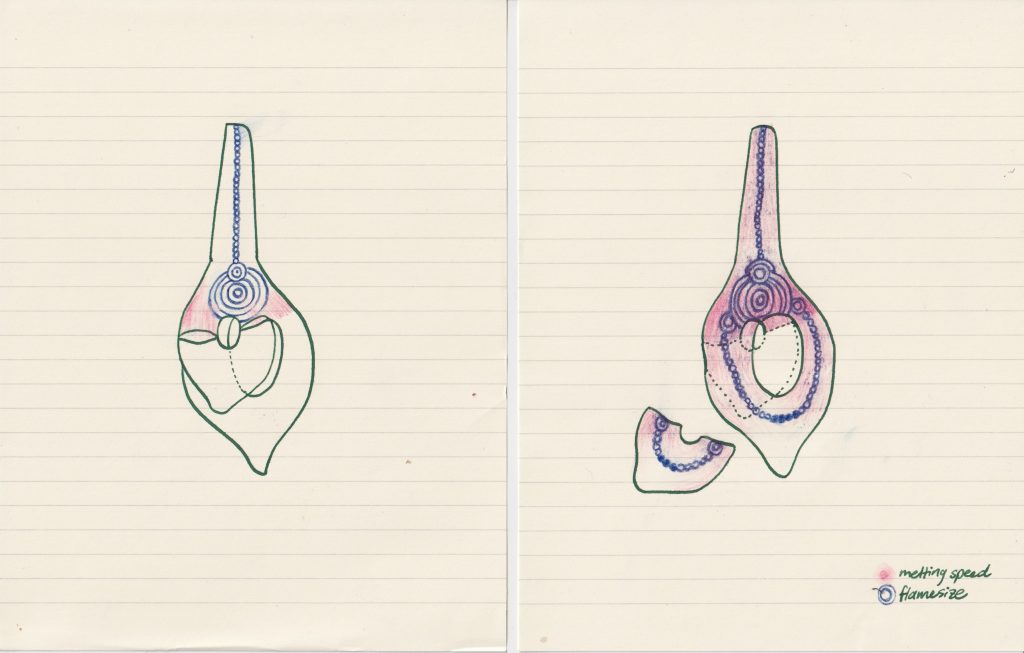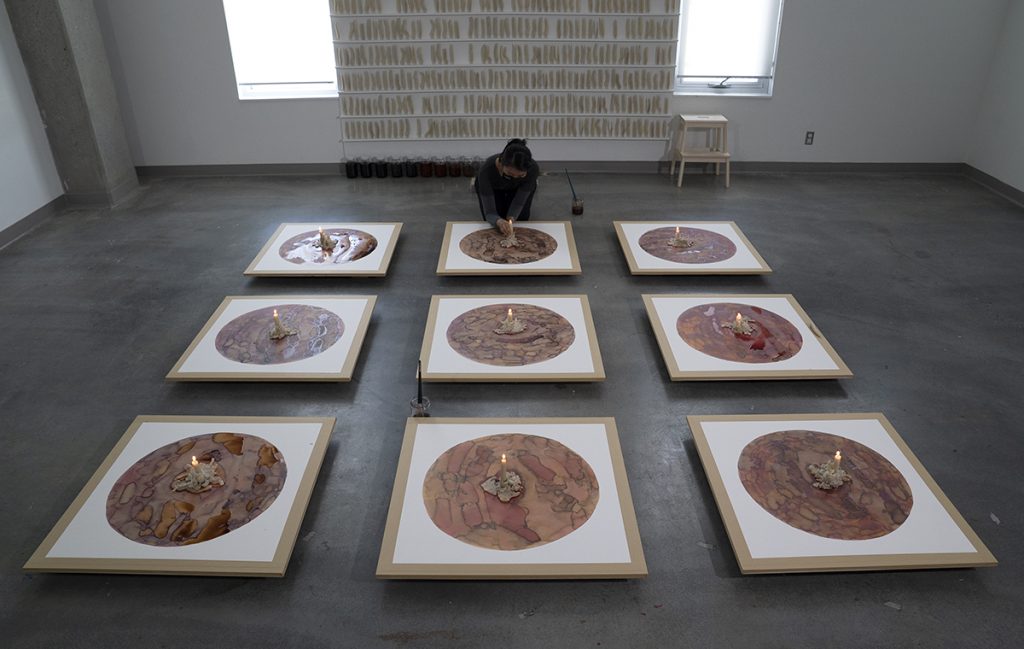
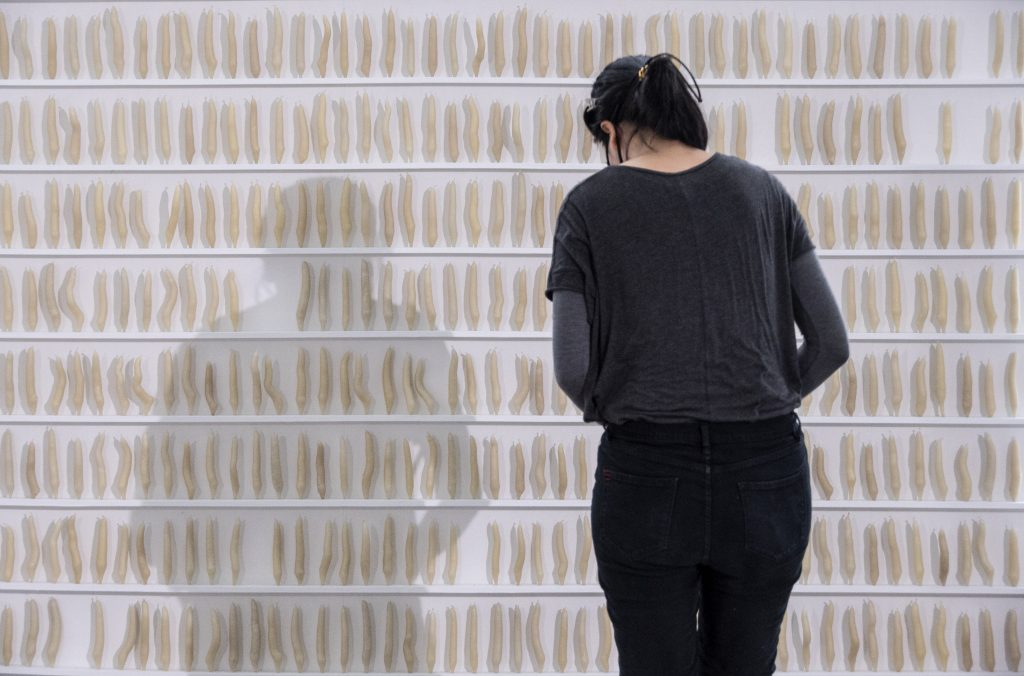
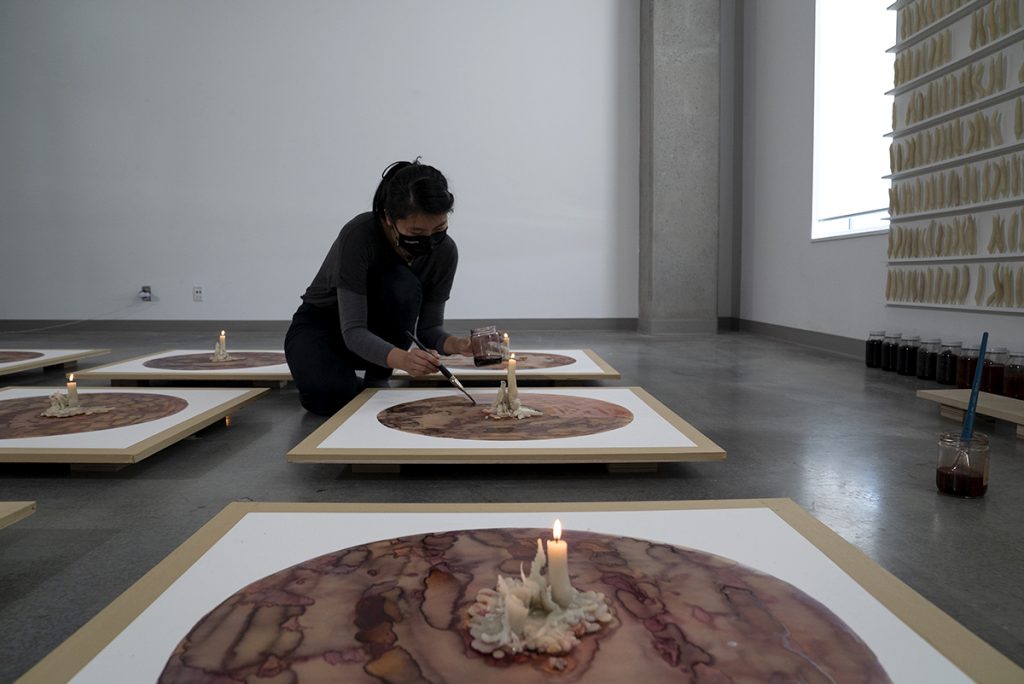
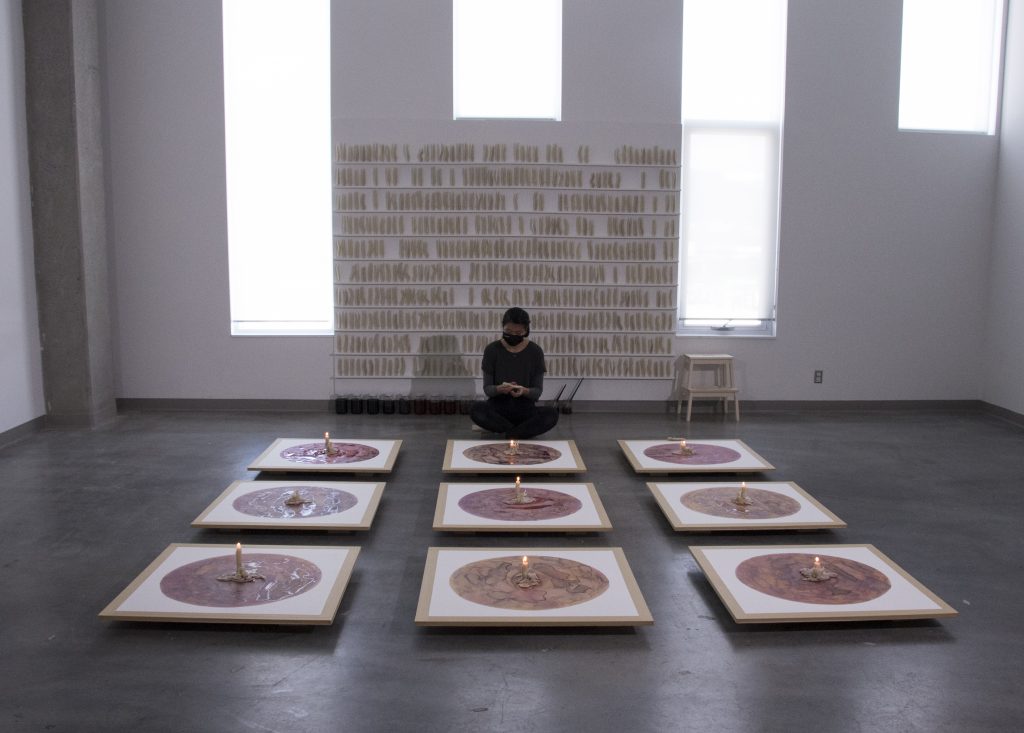
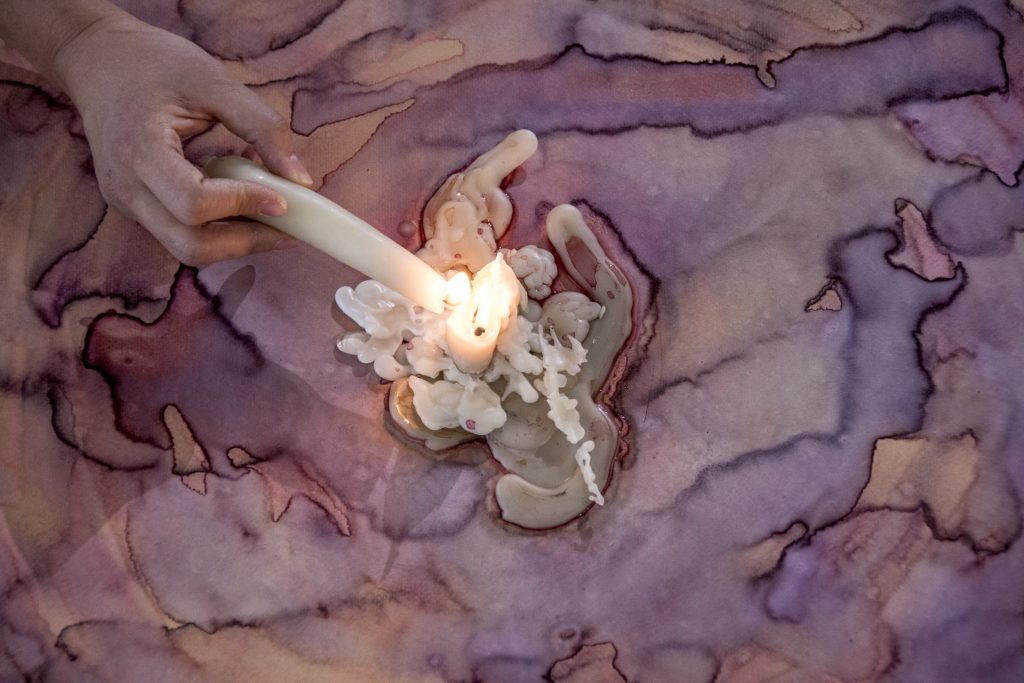
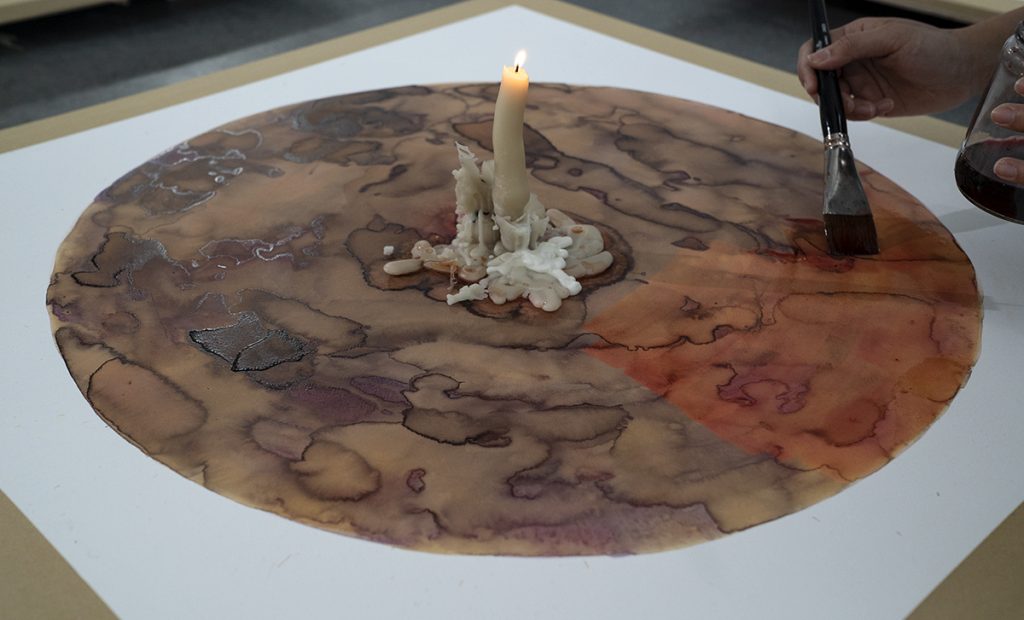
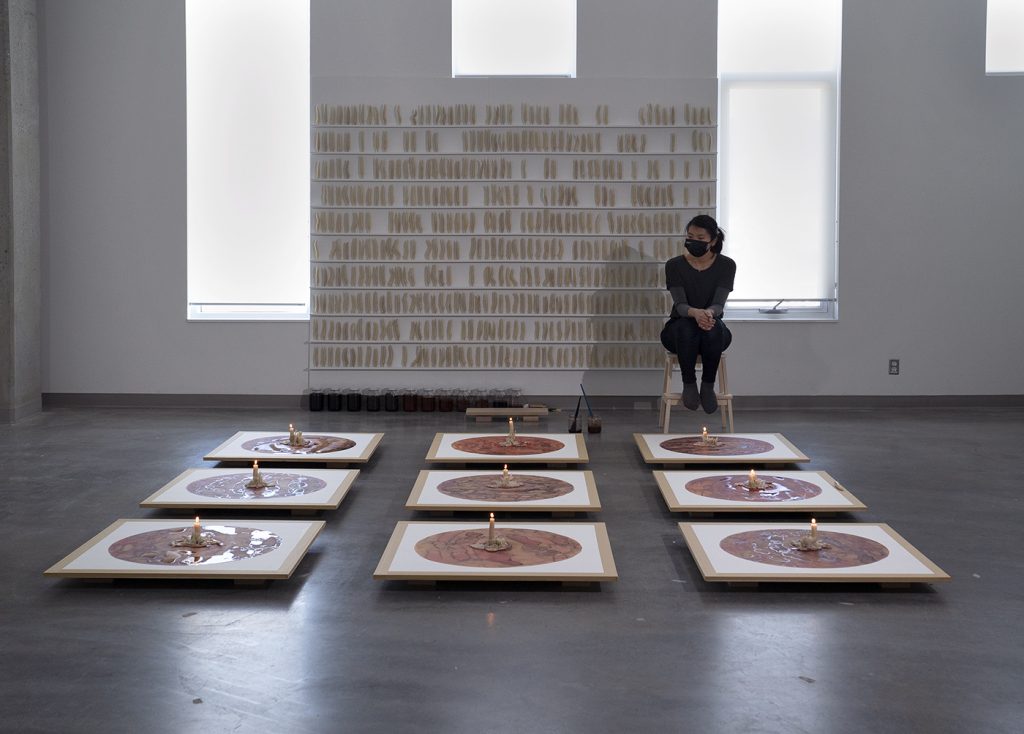
We are so often pressed for time. We spend time, buy time, save time, but rarely do we experience time. In this performance, I inhabited 40 hours by attending to candle flames and pigments made from traditional Chinese herbal medicine.







We are so often pressed for time. We spend time, buy time, save time, but rarely do we experience time. In this performance, I inhabited 40 hours by attending to candle flames and pigments made from traditional Chinese herbal medicine.
Does that mean we have to turn on the light?
Beeswax, cotton cord, words fragment


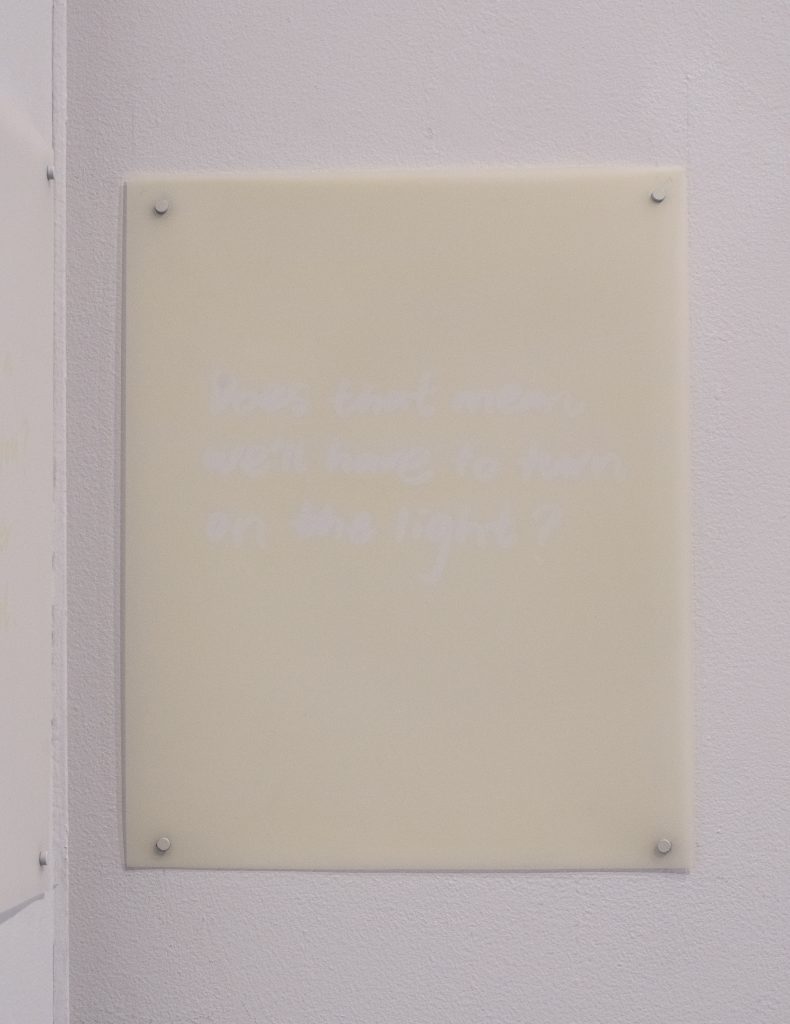
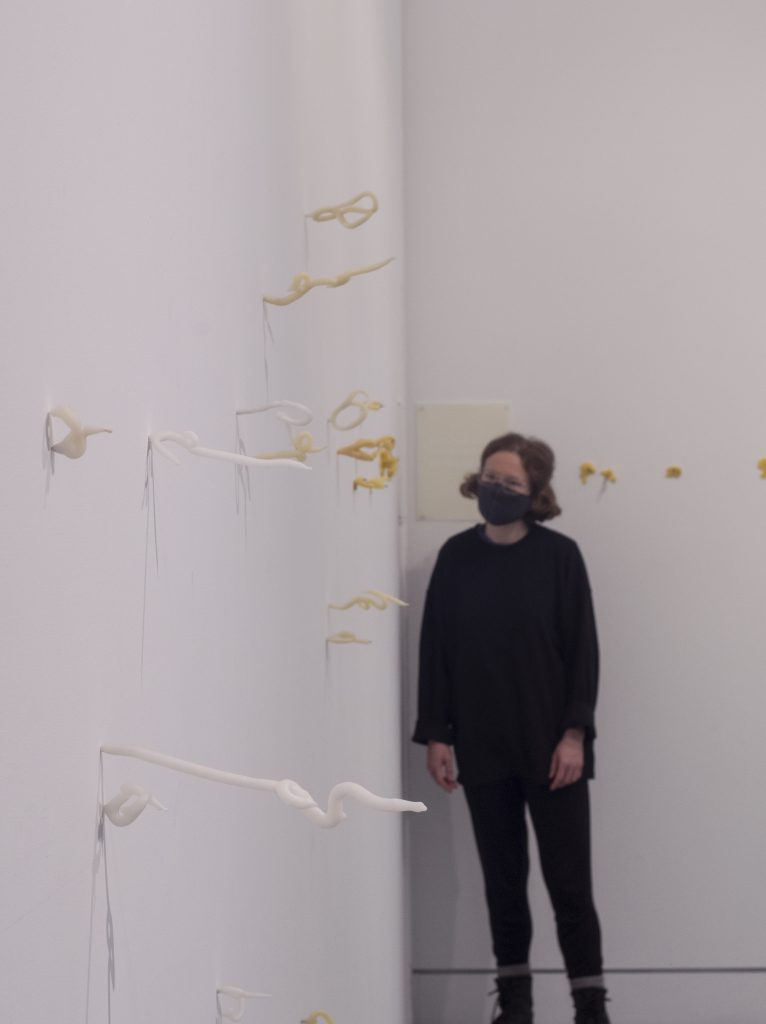

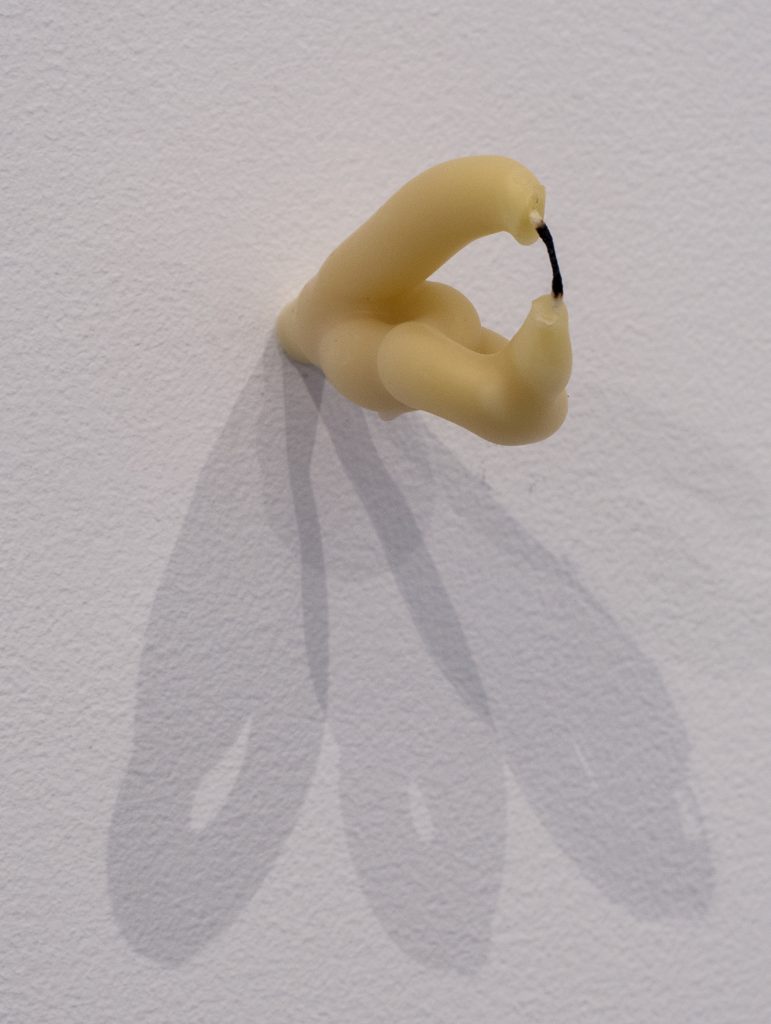
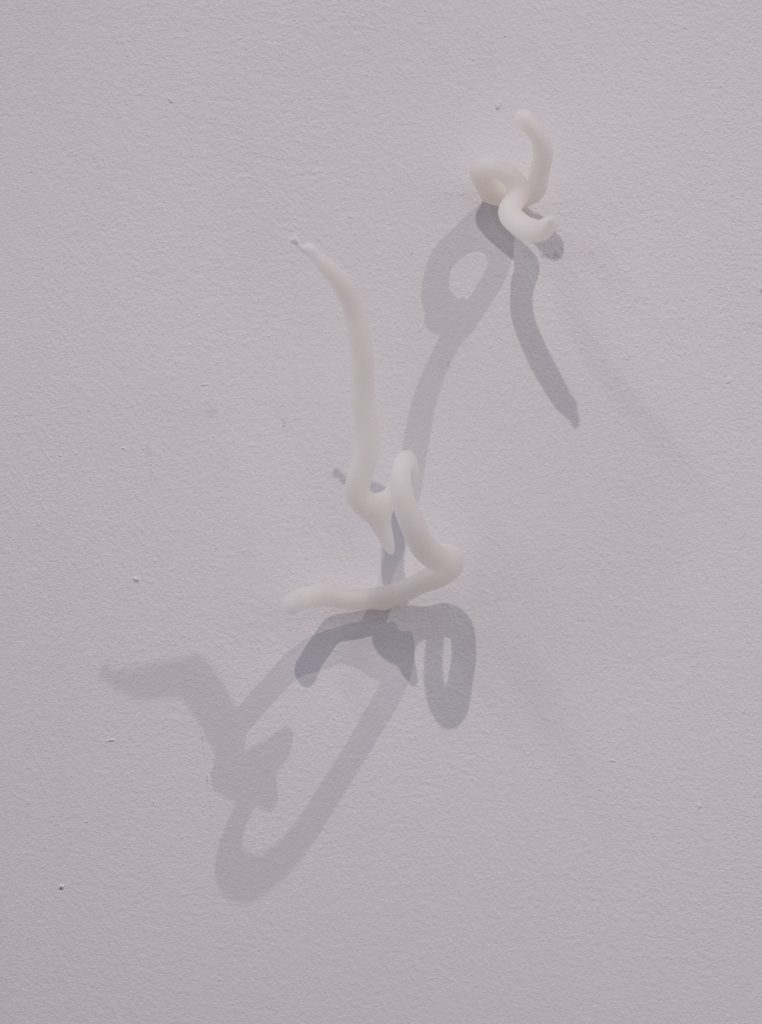
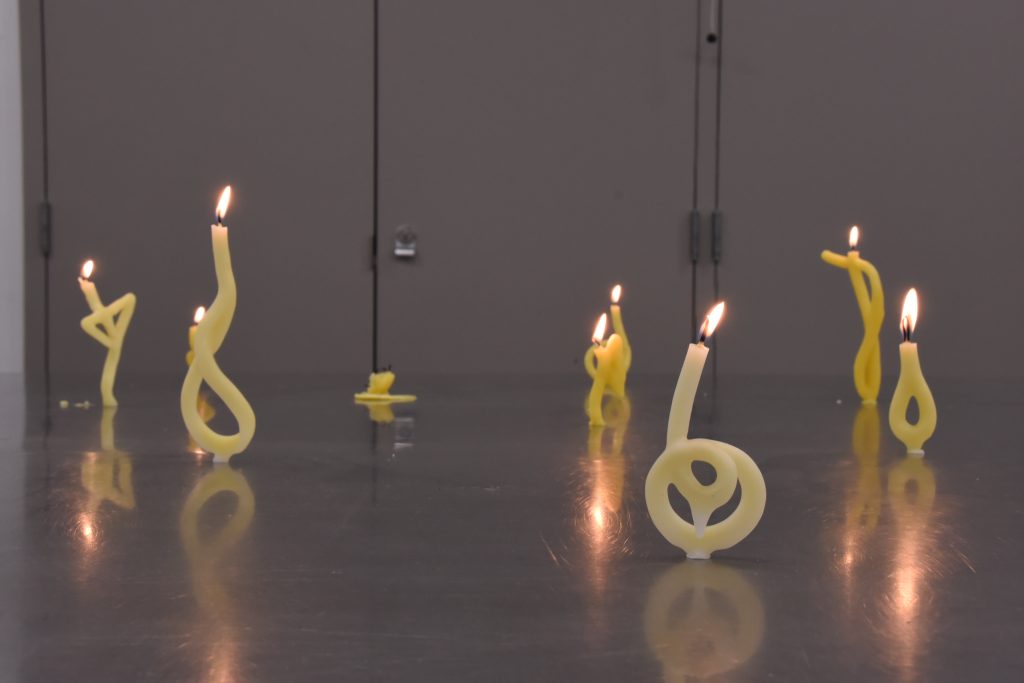
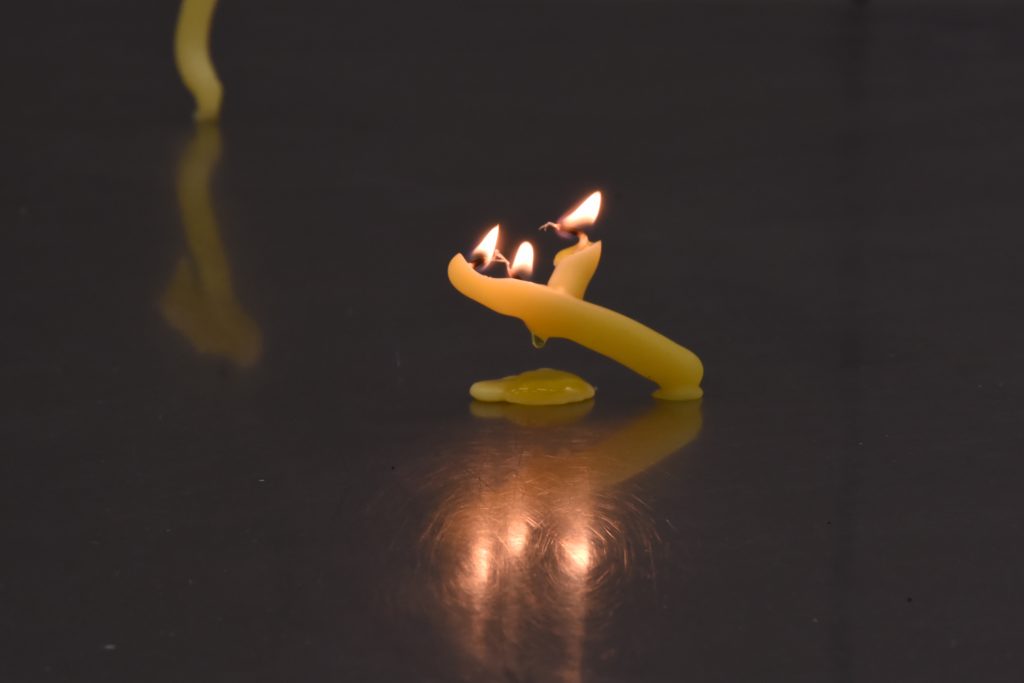
What does it mean when we observe speed or altitude changing the pace of time? How can different outcomes in time both exist in a “superposition”, or even more bafflingly, cause reality to split off into different worlds? Beyond the artificial, oversimplified construct of hours and minutes, the nature of time, which resides in all living and non-living things, is incredibly difficult to understand. For this reason, I have been drawing.
I use thin cotton cords coated with wax to draw. The balance of flexibility and structure lets me draw the line in almost any direction in space. When I’m satisfied with the drawings, I coat it in layer upon layer of wax until it becomes a candle. Neither the wax nor the wick is truly my drawing medium though. The only basic law of physics that distinguishes the past from the future is: if nothing else around it changes, heat cannot pass from a cold body to a hot one. What I am drawing with is the arrow of time – heat and the potentiality for heat.
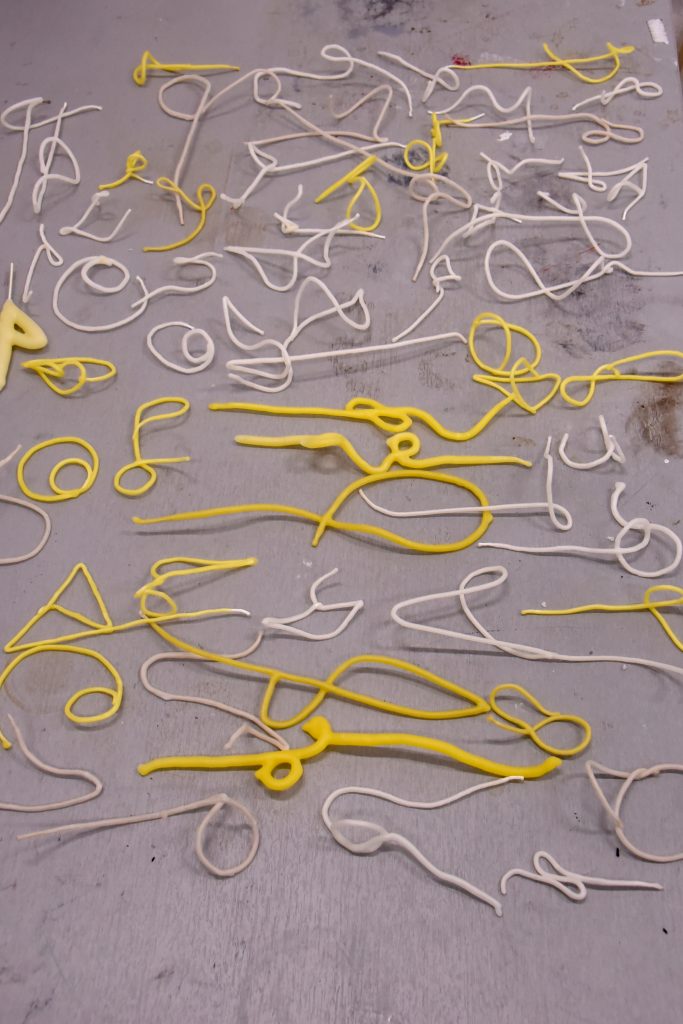
In Andy Goldsworthy’s Storm King Wall, he draws a line that extends from the highway into the river, then emerges from the water and winds through the woods with a stonewall. In Rivers and Tides, Goldsworthy says of this work, “A wall is the line that is in sympathy with the place through which it travels, and that sense of movement is very important to understanding the sculpture. All the movement and passage of people, the movement of the wall, of the stones as they run around the trees, the river of growth that is the forest. And it has made me aware of that flow around the world, the veins around the world.”
Like Goldsworthy, my drawings help me to see what surrounds us but is perhaps invisible to the everyday glance. I am not worried about the exact shape of the lines I draw, because if time is both relative to where we are and constantly splitting into different worlds, then it stands to reason that it exists in every shape, whether we are aware of them or not. I meditate on a memory of mine – important but faded, embedded underneath time – as I draw. I find that the lines I make nearer to the memory are more circular and enclosed, multiple loops leading to the same direction; those that are further away from the memory are more open, gentle bends leading to wildly shifting directions.
In Tim Ingold’s book, he writes about John Ruskin’s leading lines :
“.. lines that embody in their very formation the past history, present action and future potential of a thing. The lines of the mountain show how it has been built up and worn away, those of the tree show how it has contended with the trials of life in the forest and with the winds that have tormented it…”
The lines that I’m finding with candles wicks attempt to show not the history, present and future of a mountain or tree, but that of a memory. From the temporal location of the memory, I turn around and notice that the numerous lines of possibilities in the distance have become much fewer and more enclosed, as I get close to the moment that has already transpired.
When I install my candle drawings on the walls, they cast shadows that look like letters of a language. In Ingold’s text, he asks, at what stage does a child cease to draw letters and begin instead to write? Referencing the work of Russian psychologist Lev Vygotsky, Ingold quotes:
“There is a critical moment, however, at which the child discovers that the mark he has made on paper is a depiction of something, and moreover that this thing bears a name. Thenceforth the naming of the object can precede rather than follow the act of drawing it… But he is still not writing it. Writing calls for one further shift, prompted by the discovery that letters can be arranged in meaningful combinations to form words… Only when he can read can he also be truly said to write.”
Like the child who first draws and then discovers the name of what he has made, I have to first draw before I recognise in them the lines of tree rings, water ripples, gnarly branches, before I discover in them the movement of time. In Ingold’s terms, my candle drawings and the shadows that they cast are notations – notations with multiple but certainly not arbitrary meanings and associations. Despite the visual similarities to calligraphic strokes or alphabets, perhaps my drawings cannot become writings because I cannot read them with certainty.
But by Vygotsky’s definition, I also refuse to let my drawings become writing. In the West, alphabets are used as a tools for communicating ideas in written form. Therefore, it is not possible to write what we do not yet know. Towards the end of the Rivers and Tides, Goldsworthy expresses that it is often difficult for him to talk about his work because his drawings, made from natural materials, create for him a world beyond what words can define. But Goldsworthy’s recurring lines in nature already form a language. I want to propose that we can write what we do not yet know by letting our drawings discover their own layers of notation.
In every moment, we experience layers of time, woven from memories of the past and anticipation of the future. These layers influence how we experience the present. Now, I am sitting here writing at 9:10pm, but I am also conscious of:
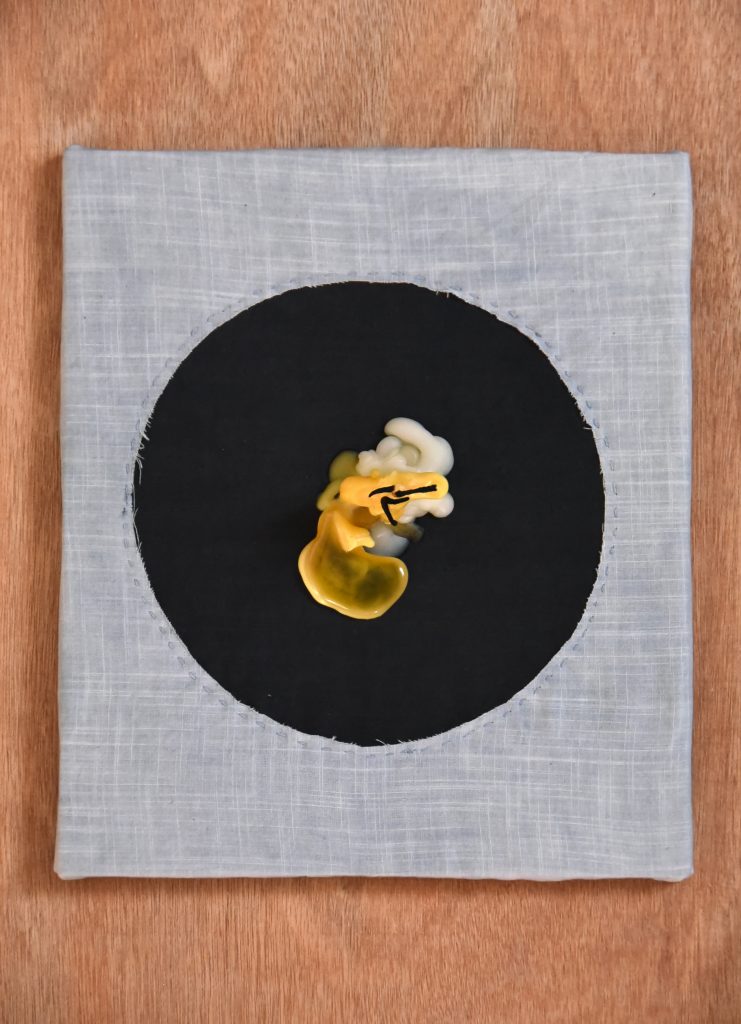
The move I made from Singapore to Vancouver last week.
The two week quarantine I am in, of which ten days have passed.
The next parcel that will arrive via DHL, which is projected to take 2 days.
The finite but unknown span of my life.
The last time I received a voice message or text from my friend Asch, who I usually hear from daily.
The move I made from Atlanta to Singapore three years ago, which made me feel just as foreign as I do now.
Some of these temporal layers have no known durations, some of them straddle across different spans of chronological time. But together, these shifting times form the ground of all my experiences.
In contemporary life, we are expected to divide time into clinical blocks of hours and minutes. We are so accustomed to converting time units into wages or prices, we constantly measure our experience of the present against the rigid divisions of hours and minutes to determine our own ‘productivity’ and value.
Because I feel that the linear and clinical way of dividing time into hours and minutes falls far short of understanding what the value of time truly is to us, I’ve been experimenting with making objects that can be used to measure and inhabit time differently.
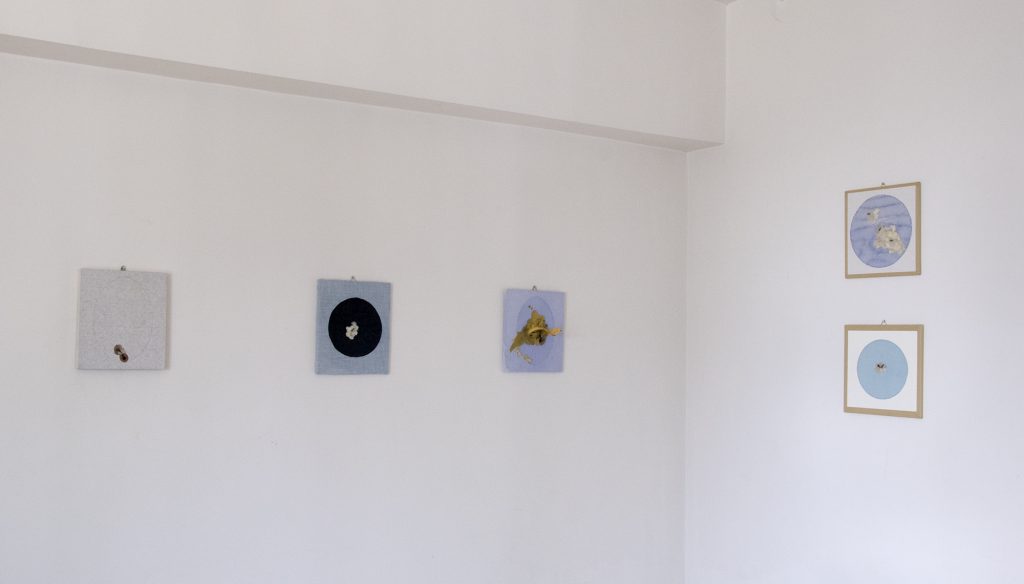
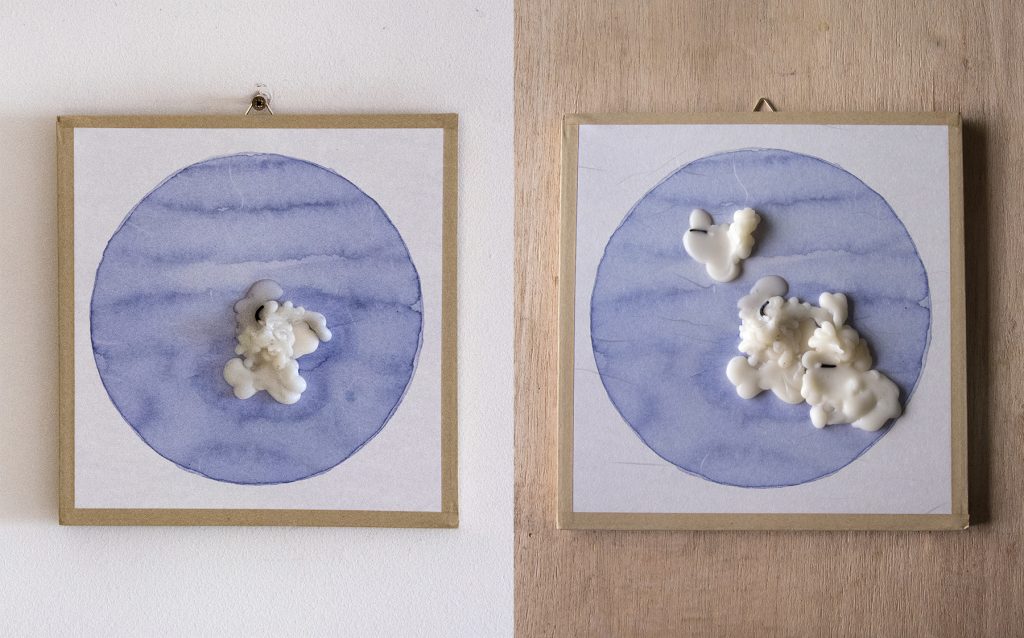
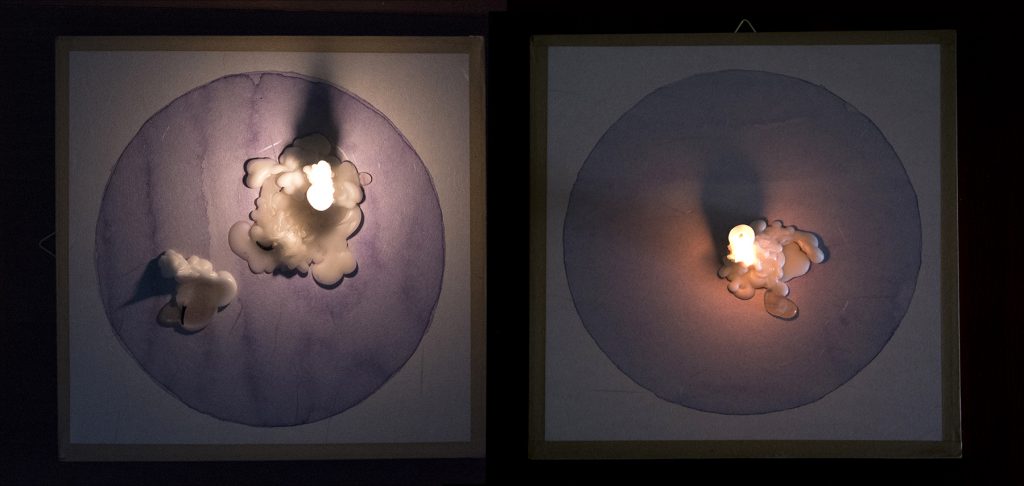
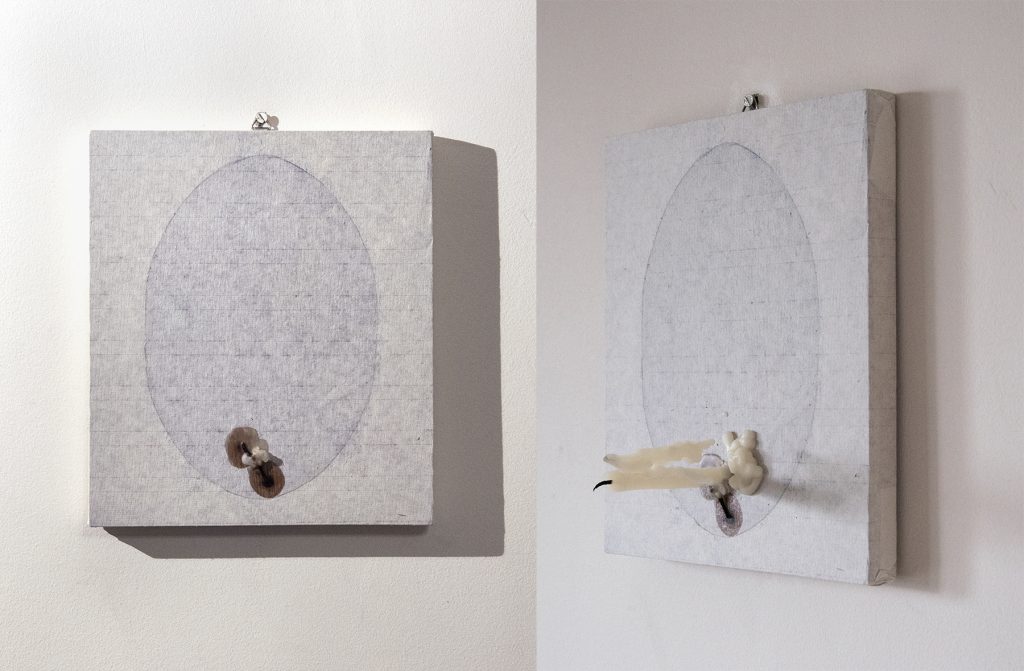
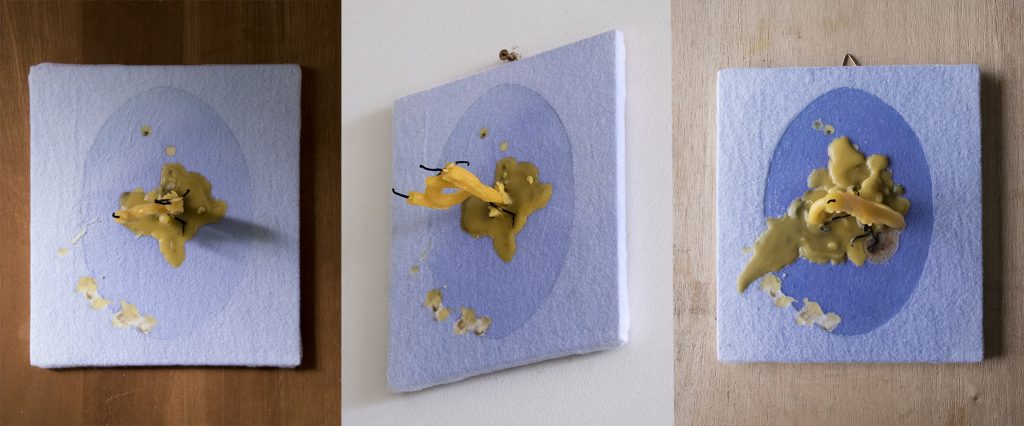
I think of these as experiments. Like I’m inventing clocks and working out the kinks. Except how I evaluate these clocks is not their mechanical precision but how they influence the way time can be experienced or visualised. Right now I’m working with candles because before the invention of pendulum clocks, candles were widely used across many parts of Asia to measure time.
I’m also interested in the heat generated by the burning of the wick. The only basic law of physics that distinguishes the past from the future is that: if nothing else around it changes, heat cannot pass from a cold body to a hot one. None of the other elemental laws of physics distinguish between the past and future.
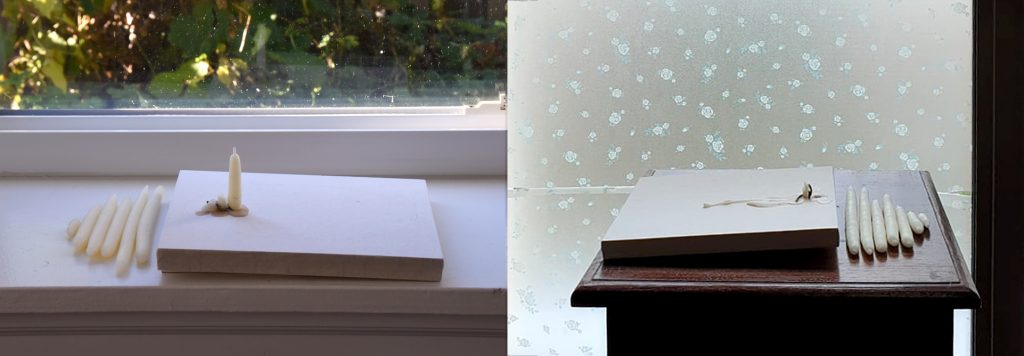
We are expected to divide time into clinical blocks of hours and minutes, but that doesn’t really allow us to understand the value of time to us. I’ve been trying to make objects that can be used to measure and inhabit time, but I’m not interested in mechanical precision.
The only basic law of physics that distinguishes the past from the future is that: if nothing else around it changes, heat cannot pass from a cold body to a hot one. None of the other elemental laws of physics distinguish between the past and future.
Time moves at different speeds in different places
Times moves at different speeds depending on how fast you’re moving.
Most of the universe consists of times that neither the future, present or past relative to us.
How do I touch what is too abstract and large to really understand or experience?
Making holders that could gather and divert the flow of melted wax. I’m wondering if these can be draw tools of some kind, marks that record.
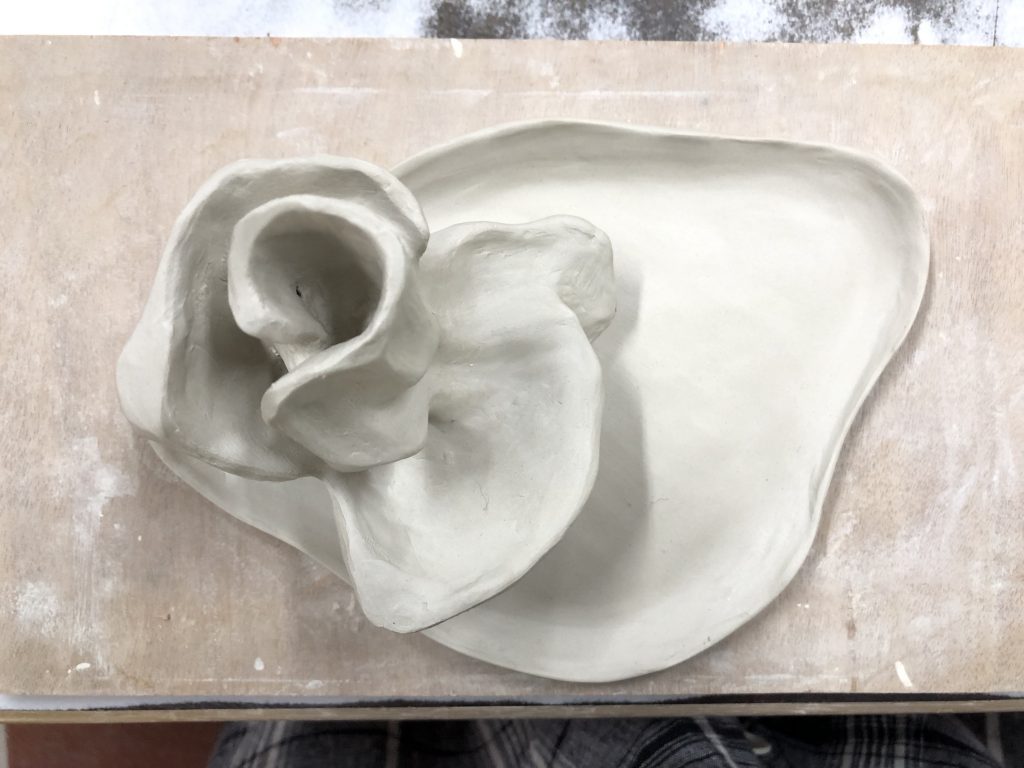
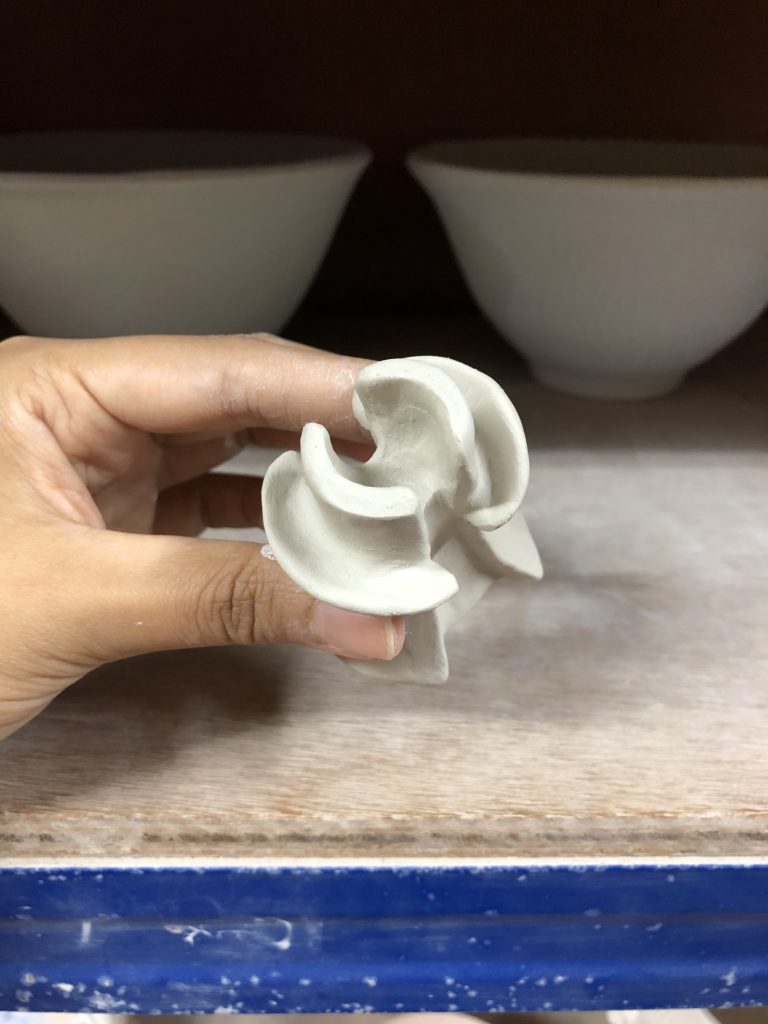
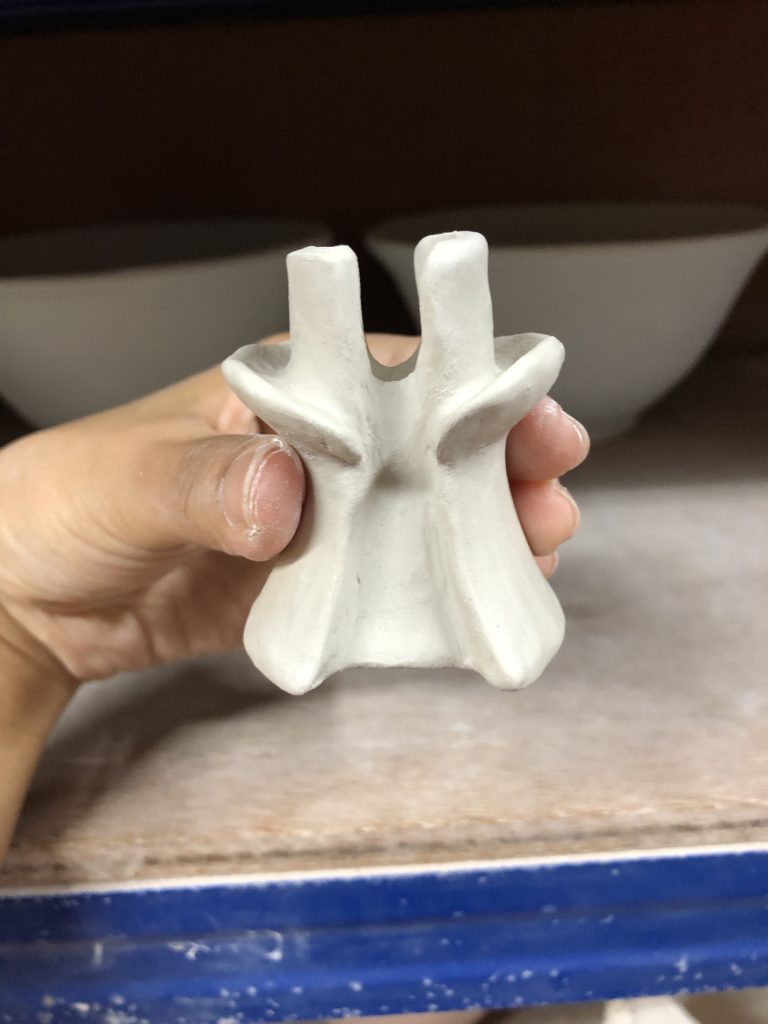
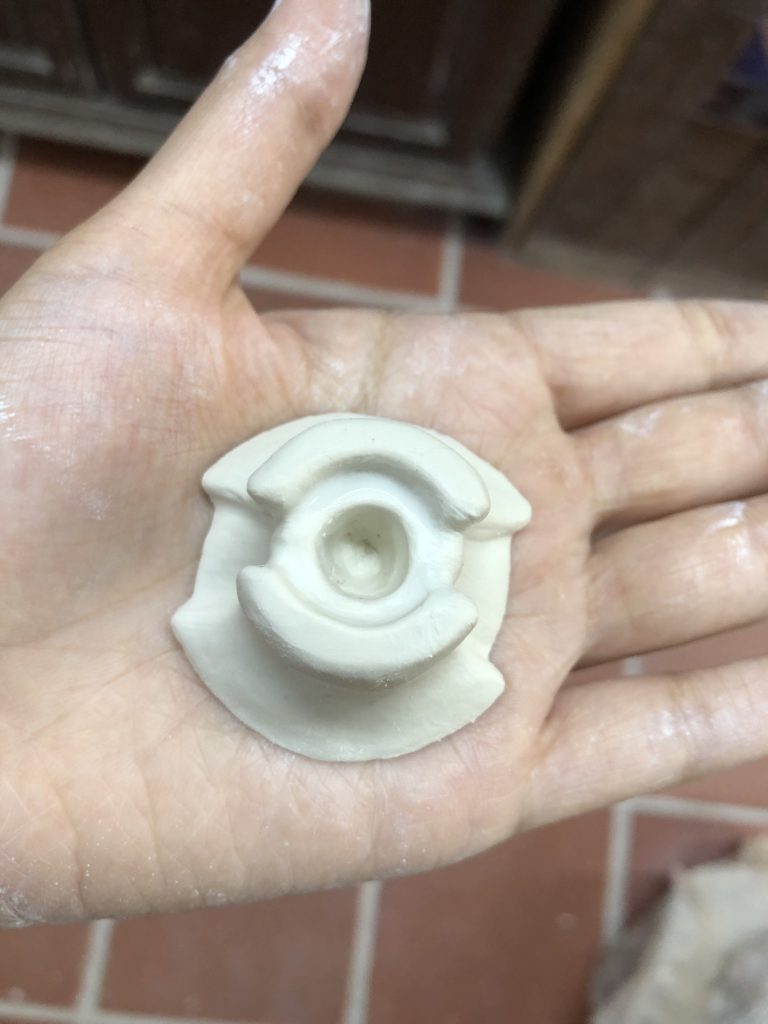
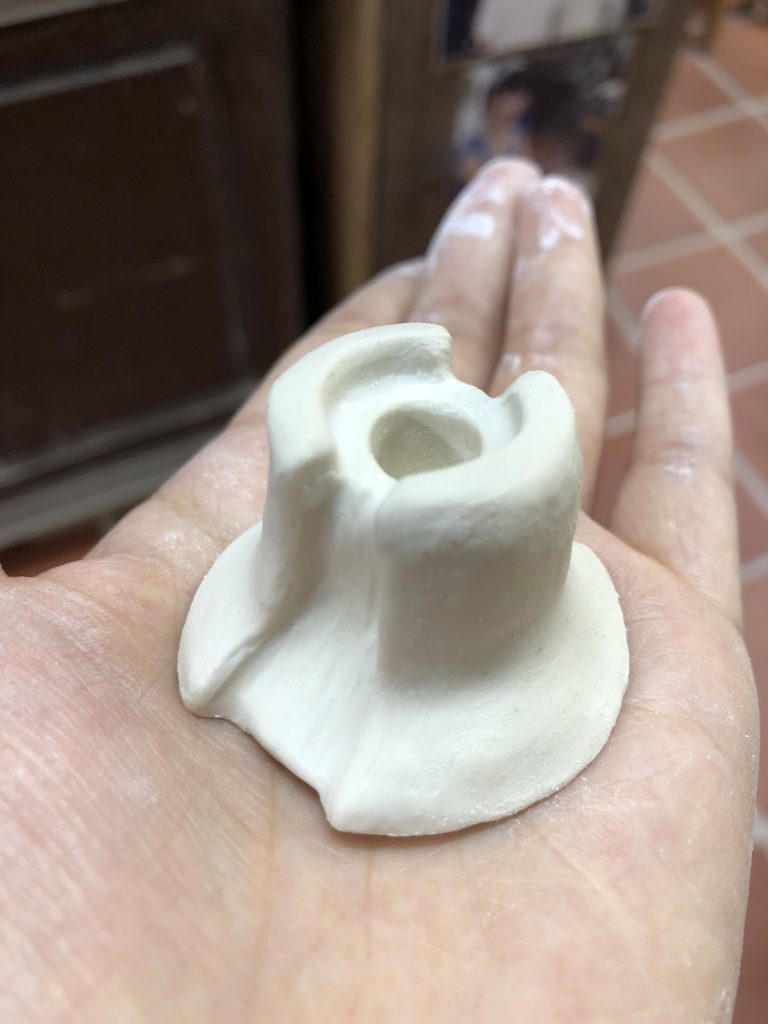
Made this form while thinking about Rovelli’s diagrams of time structures:
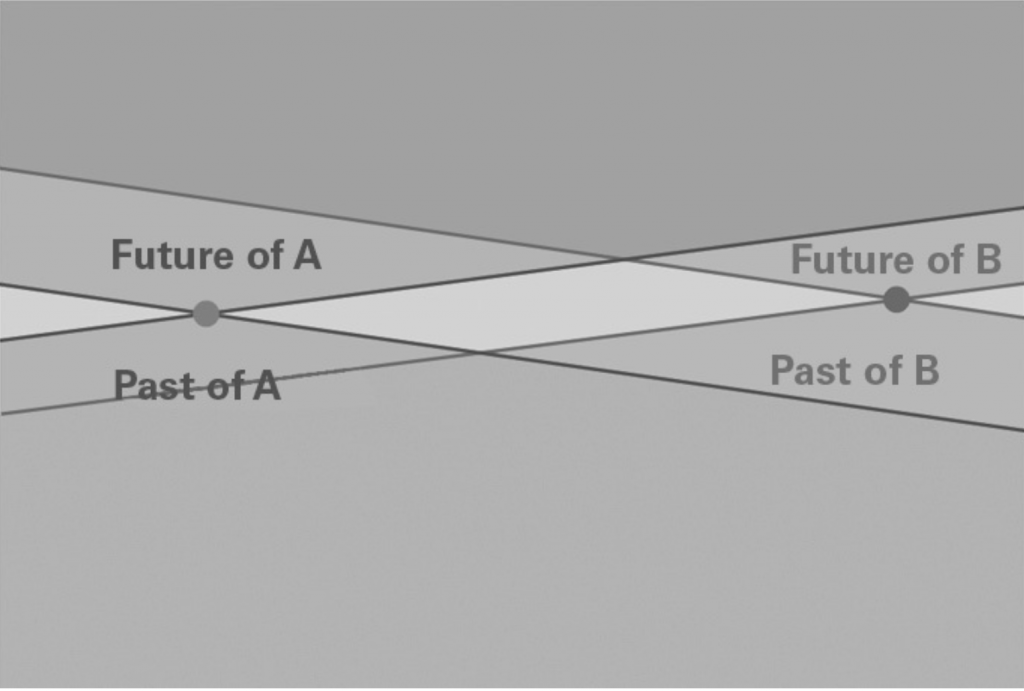
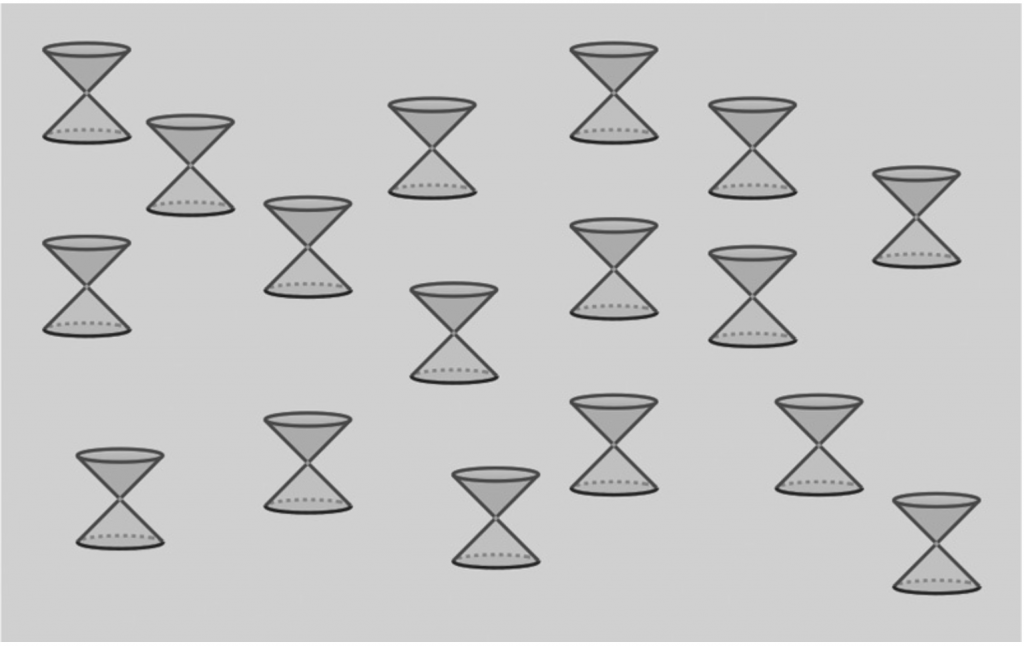
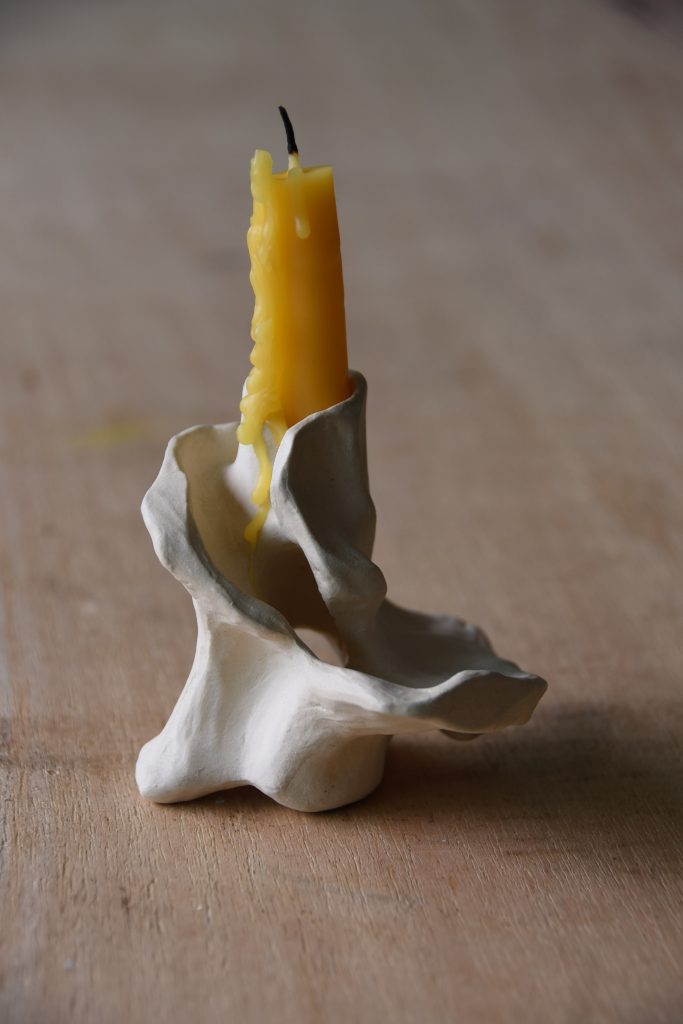
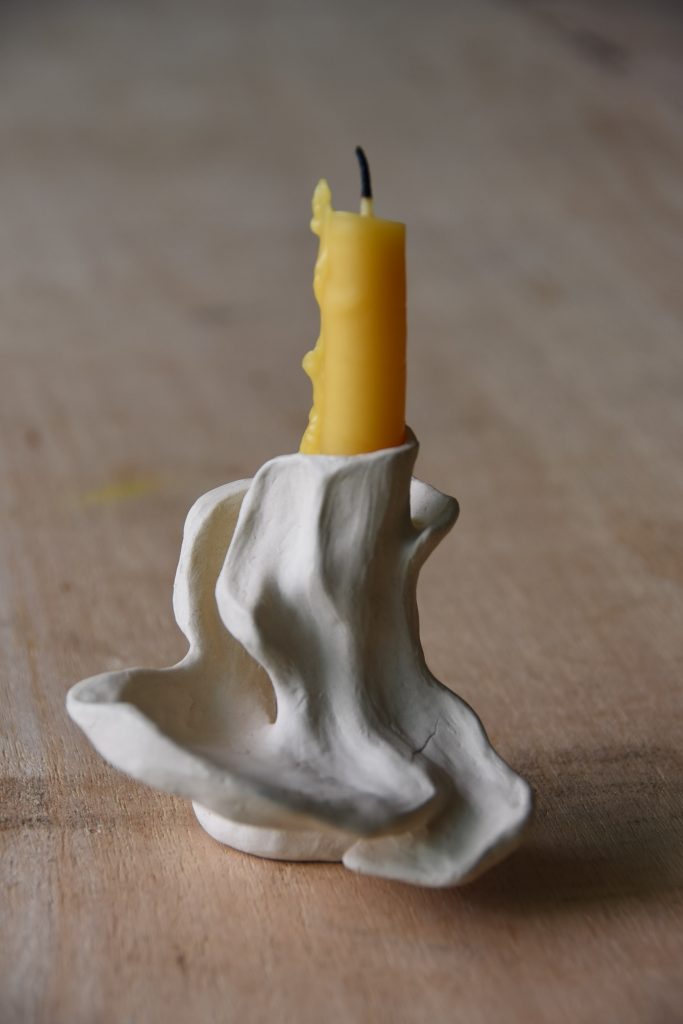
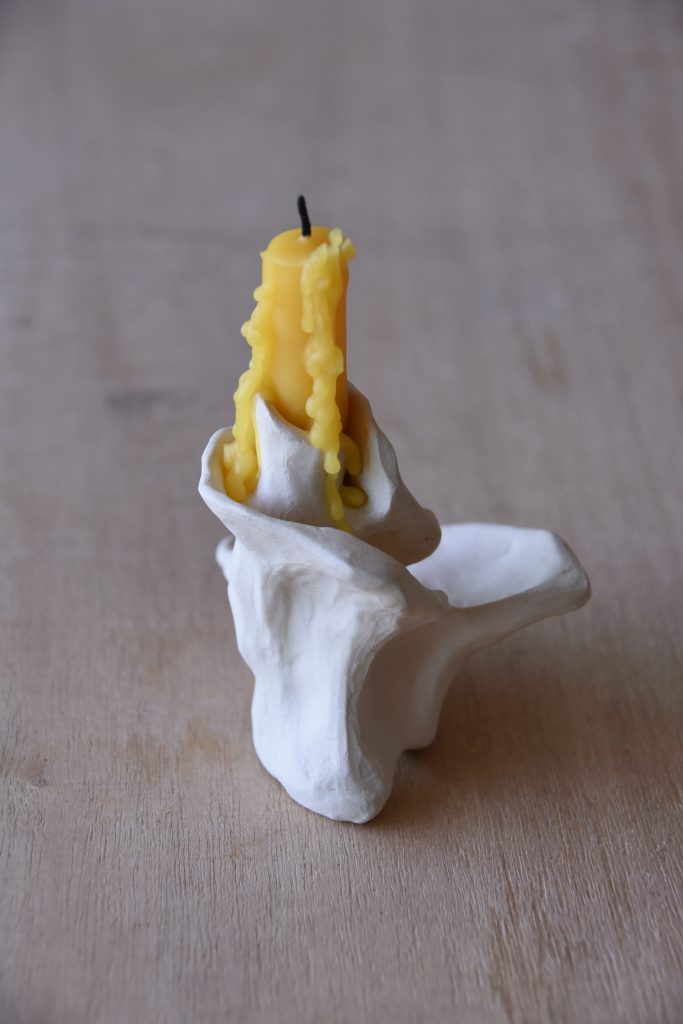
A good friend of mine was leaving Singapore. It seemed as good a time as any to make more of the wick-candles.
This time they turned out wilder for some reason, they felt more animate to me. I have been thinking a lot about the magic readings. They resonated with me in a way I never expected.
I’ve been thinking about those ideas, I just didn’t know they were could be called magic.
Here are a few lines from What Lenin Teaches Us About Witchcraft,
by Oxana Timofeeva and Reclaiming Animism, by Isabelle Stengers.
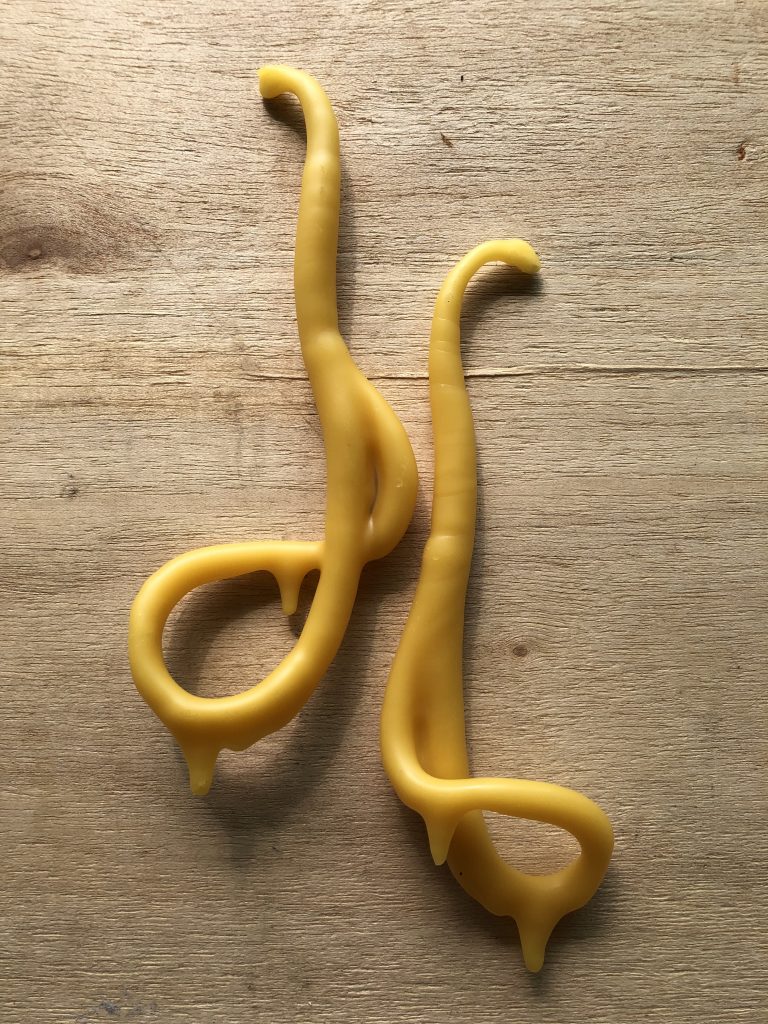
What makes slight-of-hand magic possible is “the way the sense themselves have, of throwing themselves beyond what is immediately given, in order to make tentative contact with the other sides of things that we do not sense directly”.
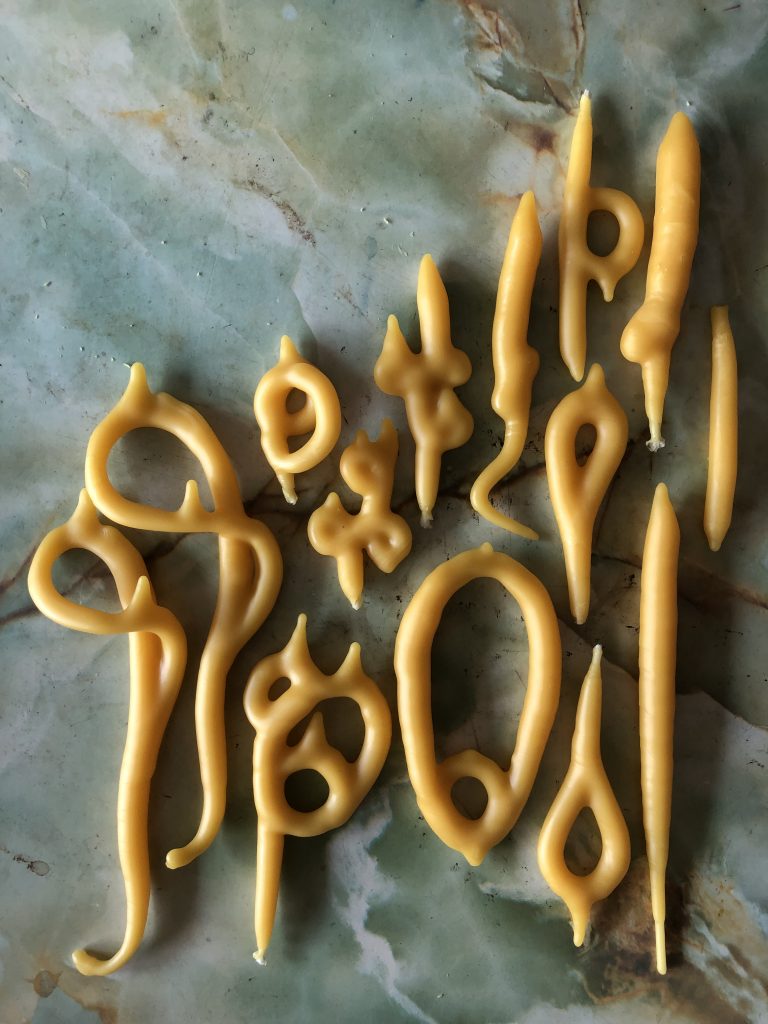
Our millieu entices us to feel that we bear the high responsibility to determine what “really” exists and what does not. It is a milieu that is ruled by the power of judgmental critique.
Scientists are infected, of course, as are all those who accept their authority to decide what objectively exists. But also infected might be those who would claim to be animists, if they affirm that rocks “really” have souls or intentions, like humans.
A poisoned milieu must be reclaimed. So must many of our words, those that – like ‘animism’ and ‘magic’ – carry with them the power to take us hostage: do you “really” believe in…?
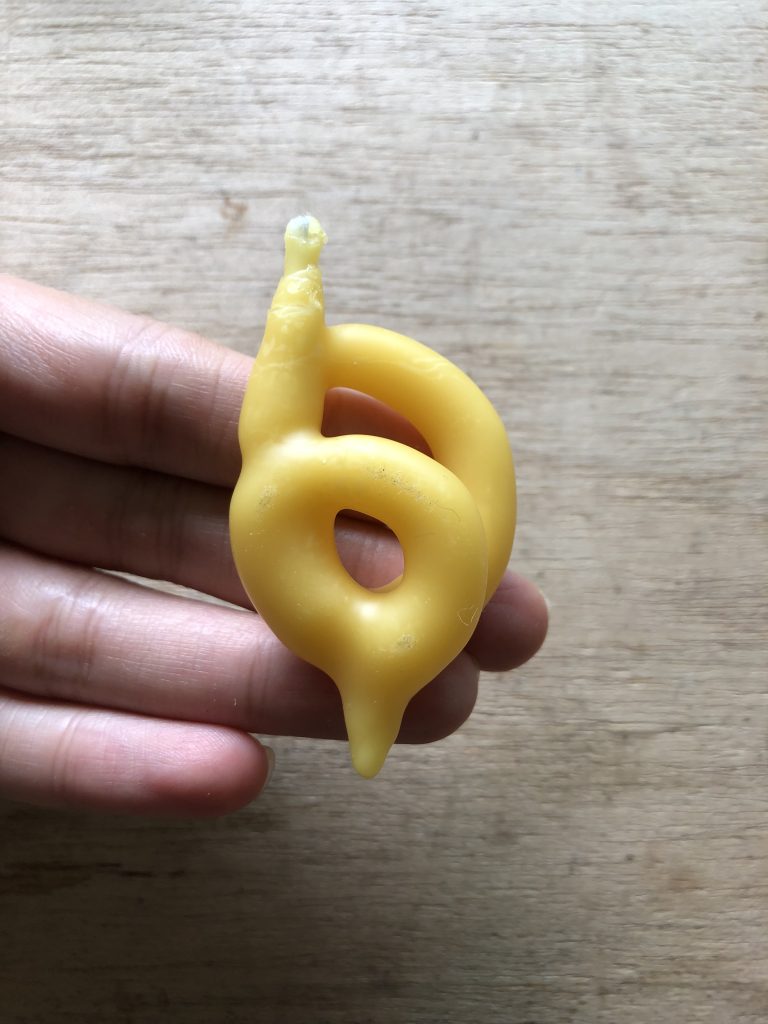
The main source of her magic is her firm belief in herself, which she perhaps acquires at precisely her worst moments of loss and catastrophe.
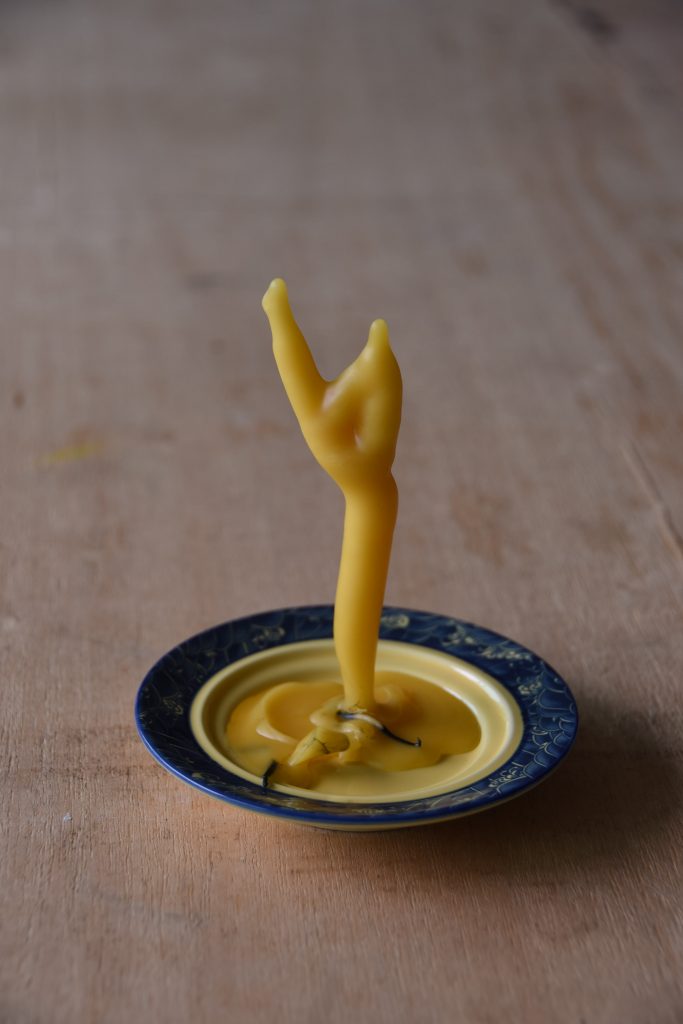
Neo-pagan witches call their own craft “magic”: naming it so, they say, is itself an act of magic, since the discomfort it creates helps us notice the smoke in our nostrils.
I started rereading In The Order of Time. Made these small drawings to try to understand the structure of time as Rovelli describes it.
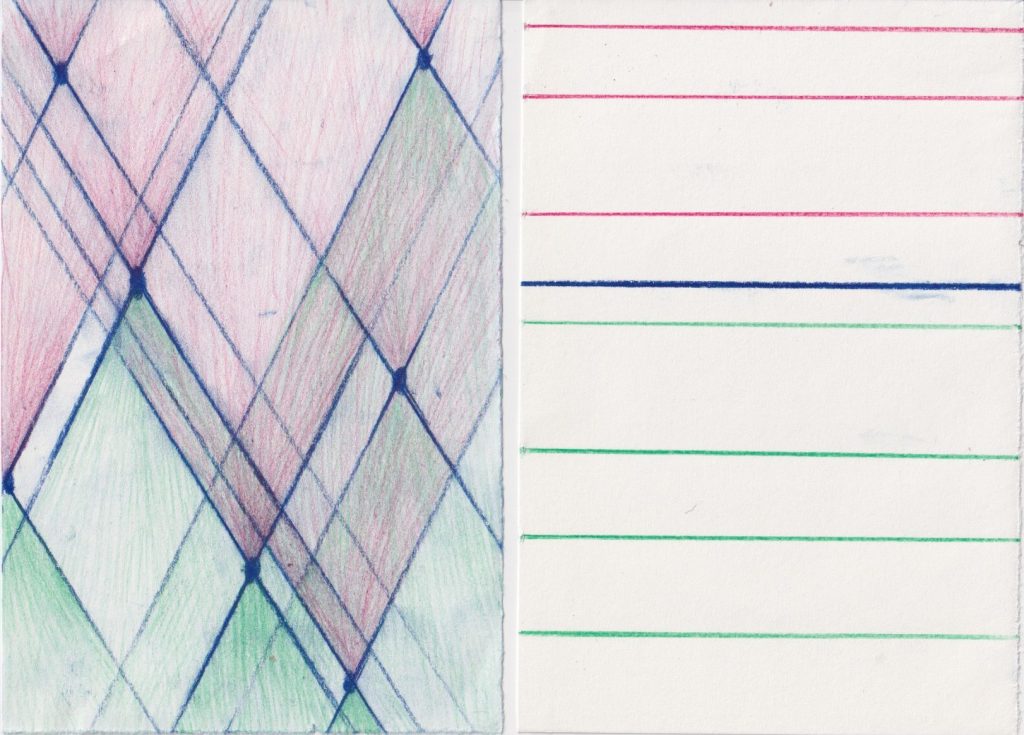
I seem to take pleasure in discovering over and over my perceptions and assumptions about the world around me are inaccurate. Amongst many other surprising properties, I read that:
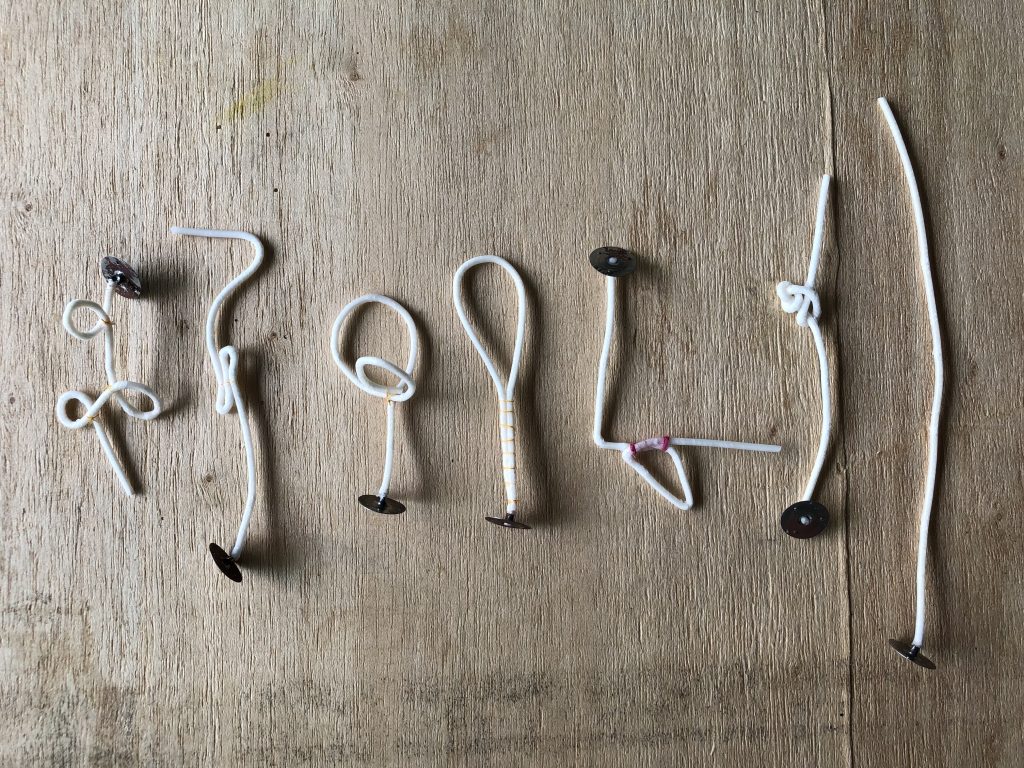
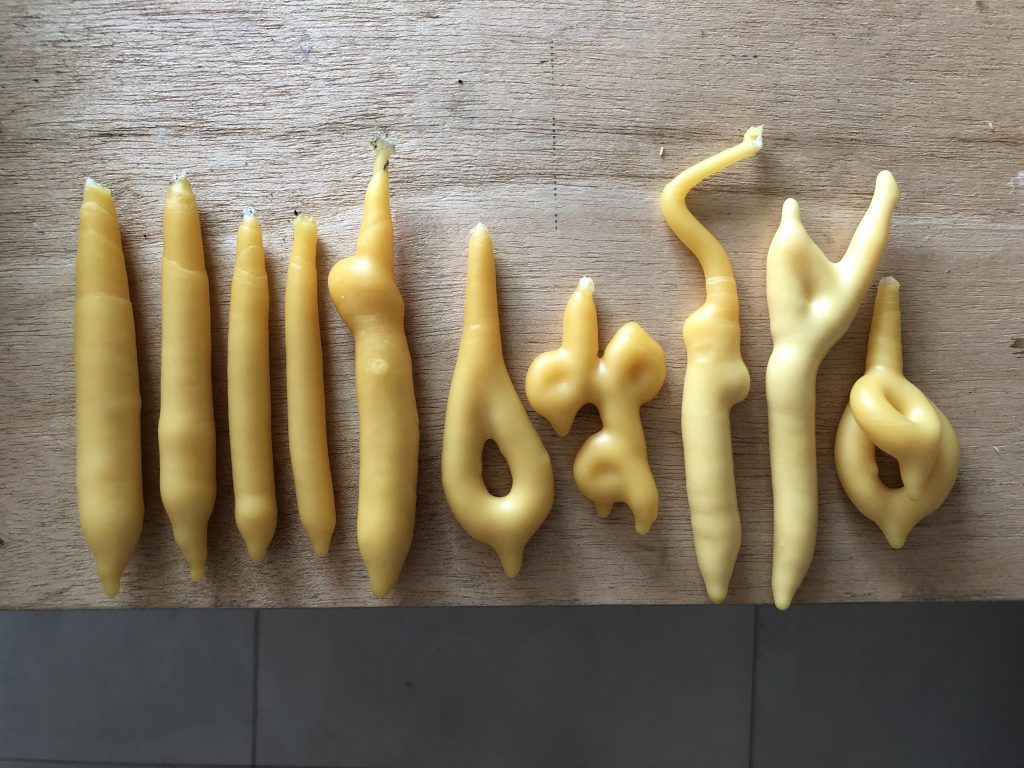
Unlike the many candles I made previously, the shapes of these candles were determined by their internal structure.
I liked that I couldn’t predict how they would burn until they were lit. I purposely created conundrums where it seemed like the flame might have to choose one path or the other. It seemed fitting of the characteristics of time I was reading about in Rovelli’s book.
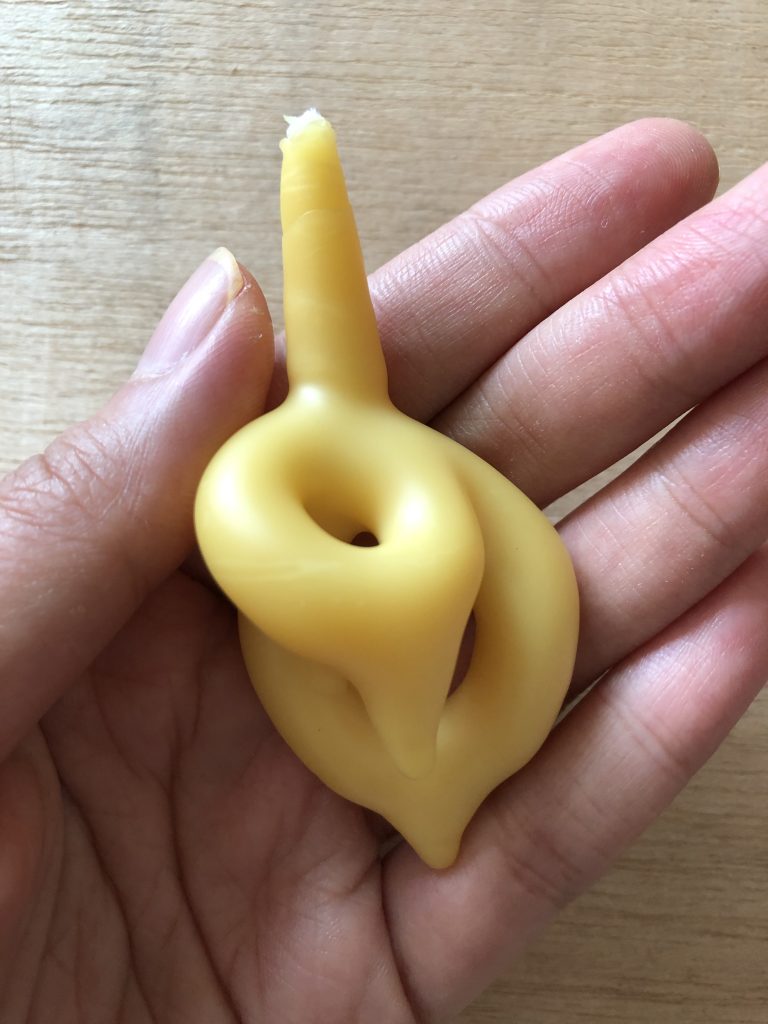
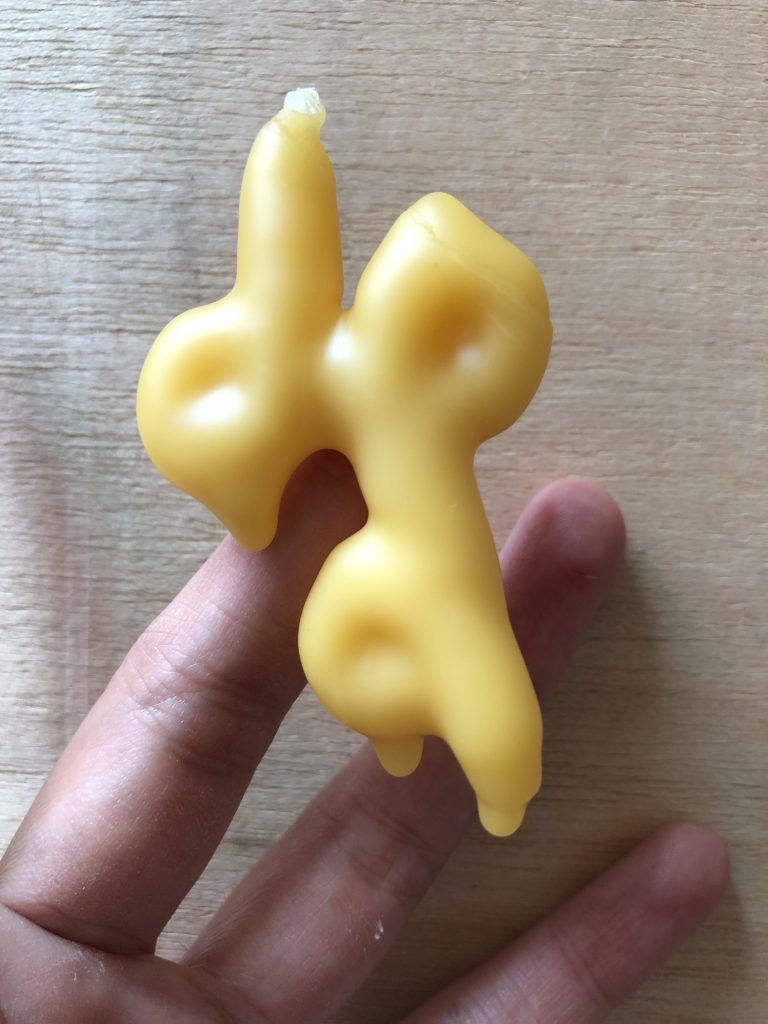
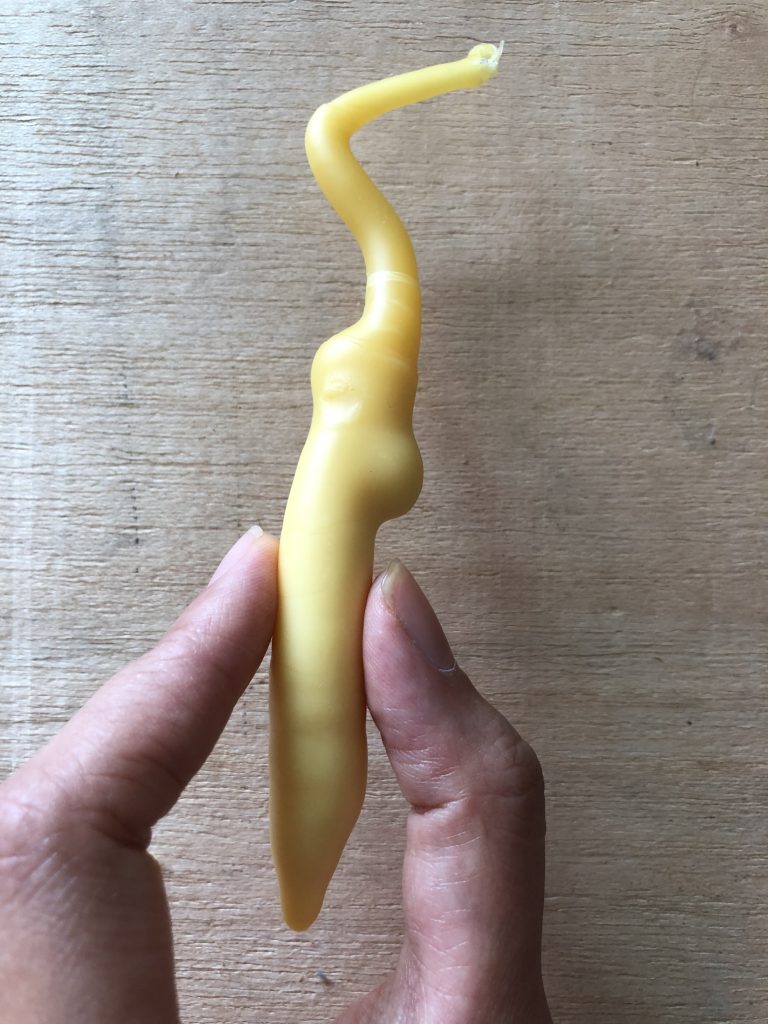
I liked how they looked like small roots to be used in herbal spells when held in my hands.
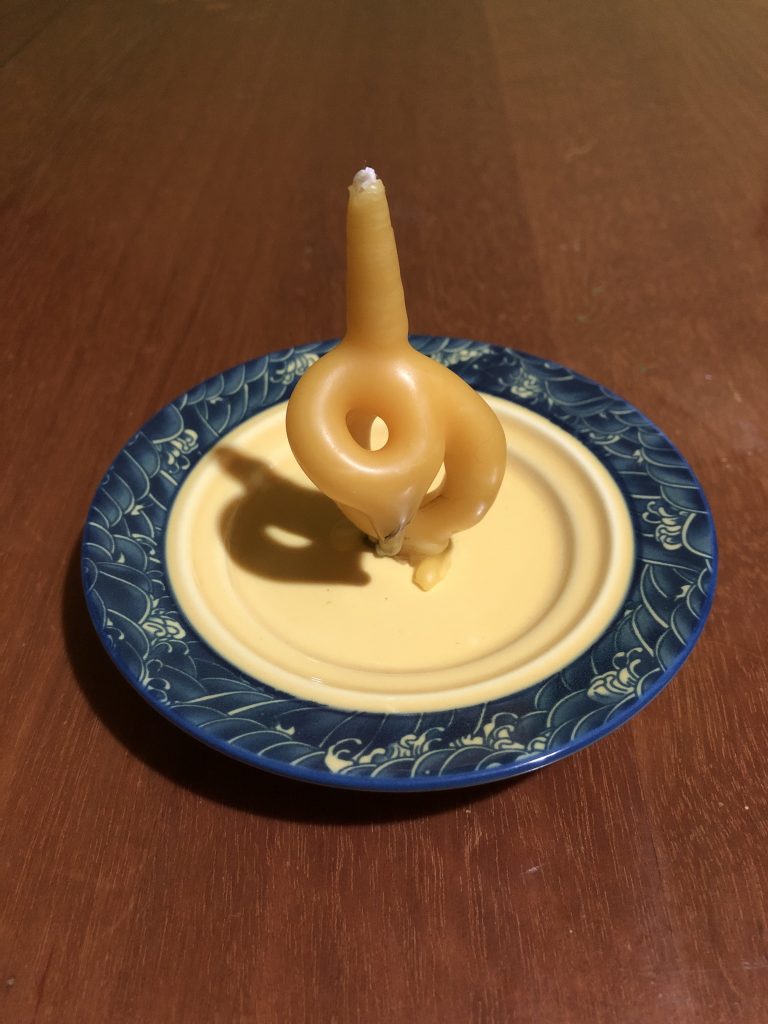
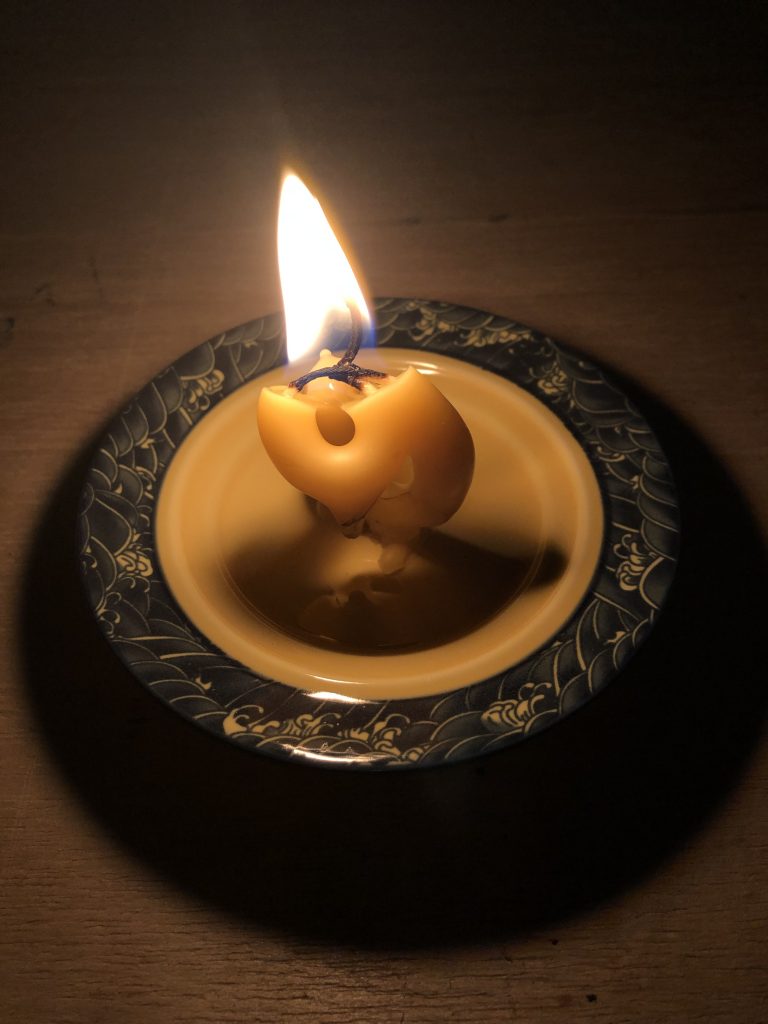
I always struggle with documentation.
On one hand it seems essential for ephemeral processes. On the other I find it extremely challenging to not get caught up in the image I’m creating and just pay attention to the present moment.
I couldn’t resist taking one photo while burning this first one. But for most of the time I took detailed annotations on the flame size and melting speed instead:
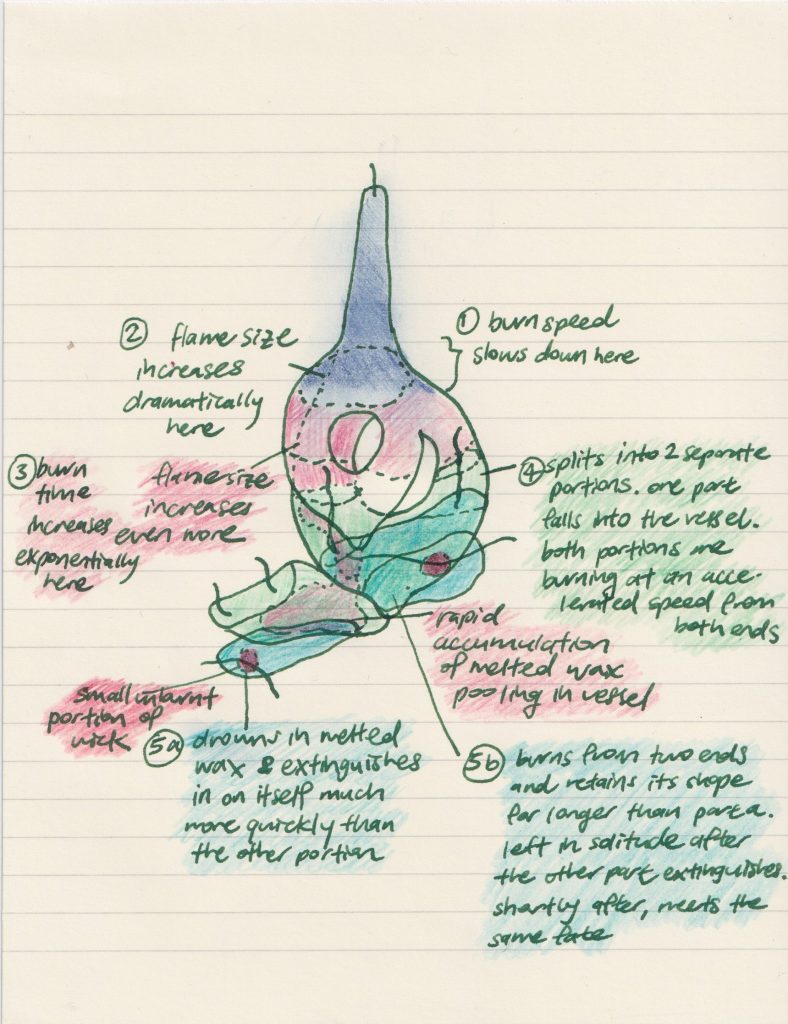
Then I used the information above to redraw in a more streamlined form.
